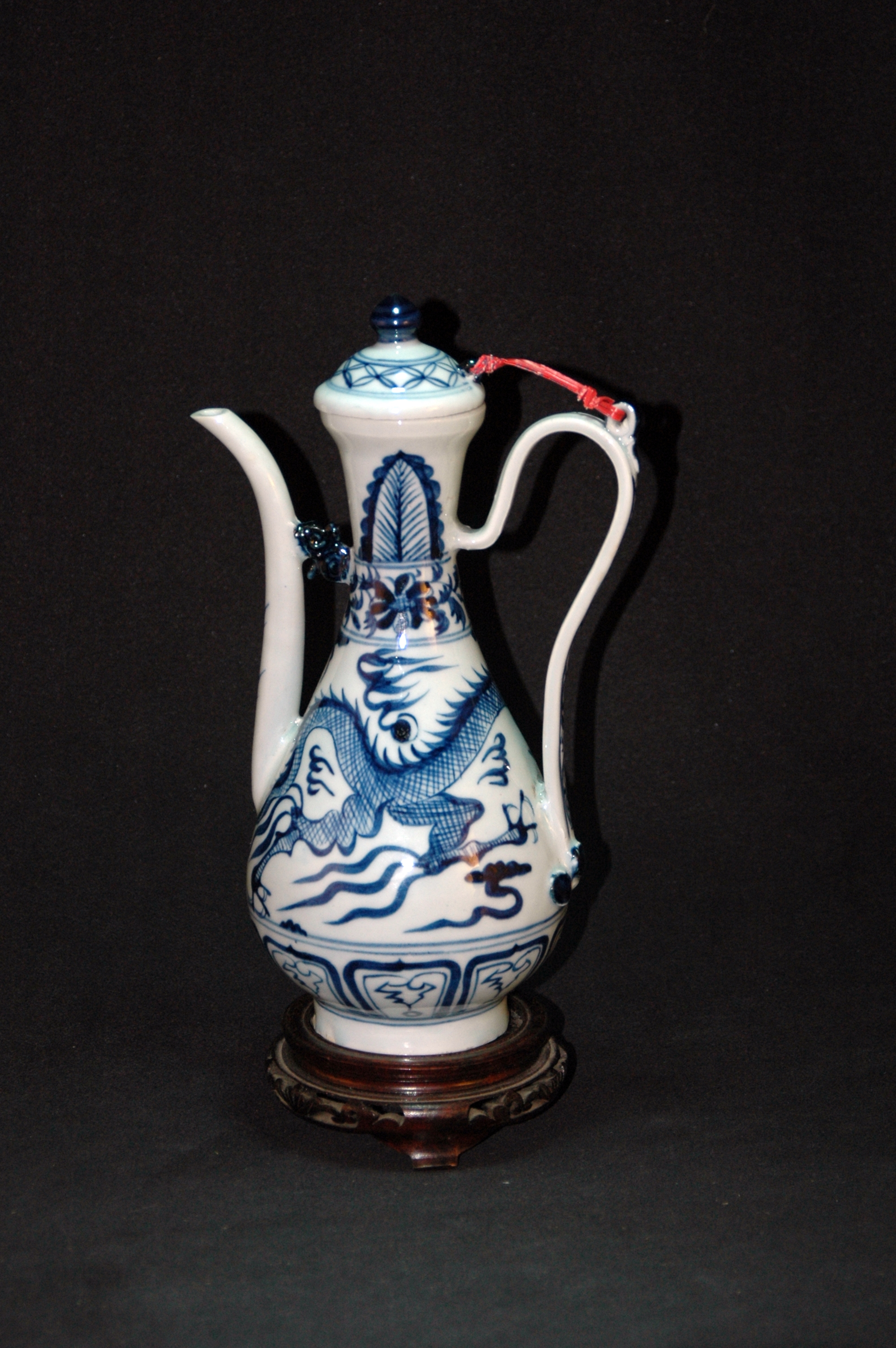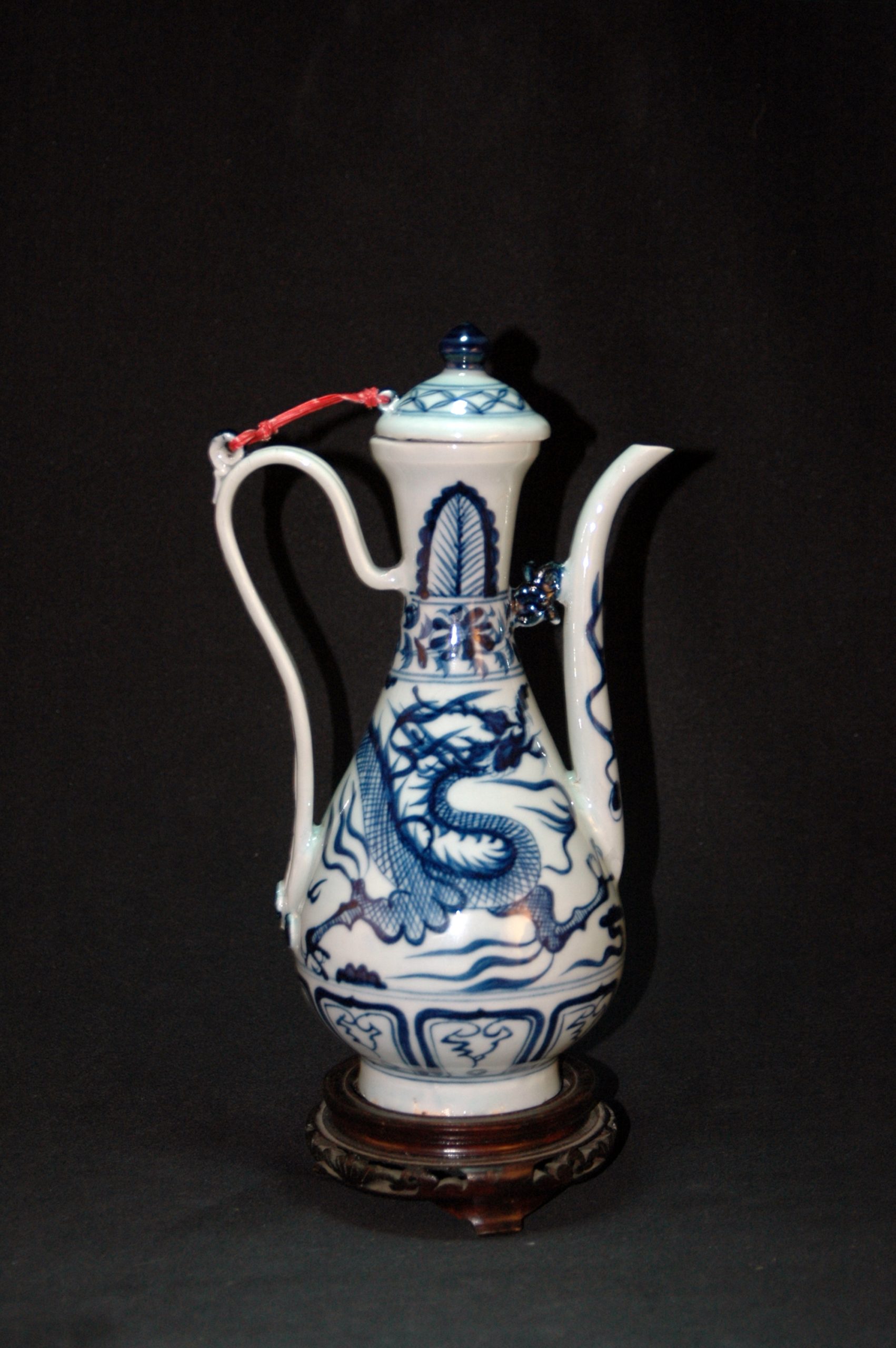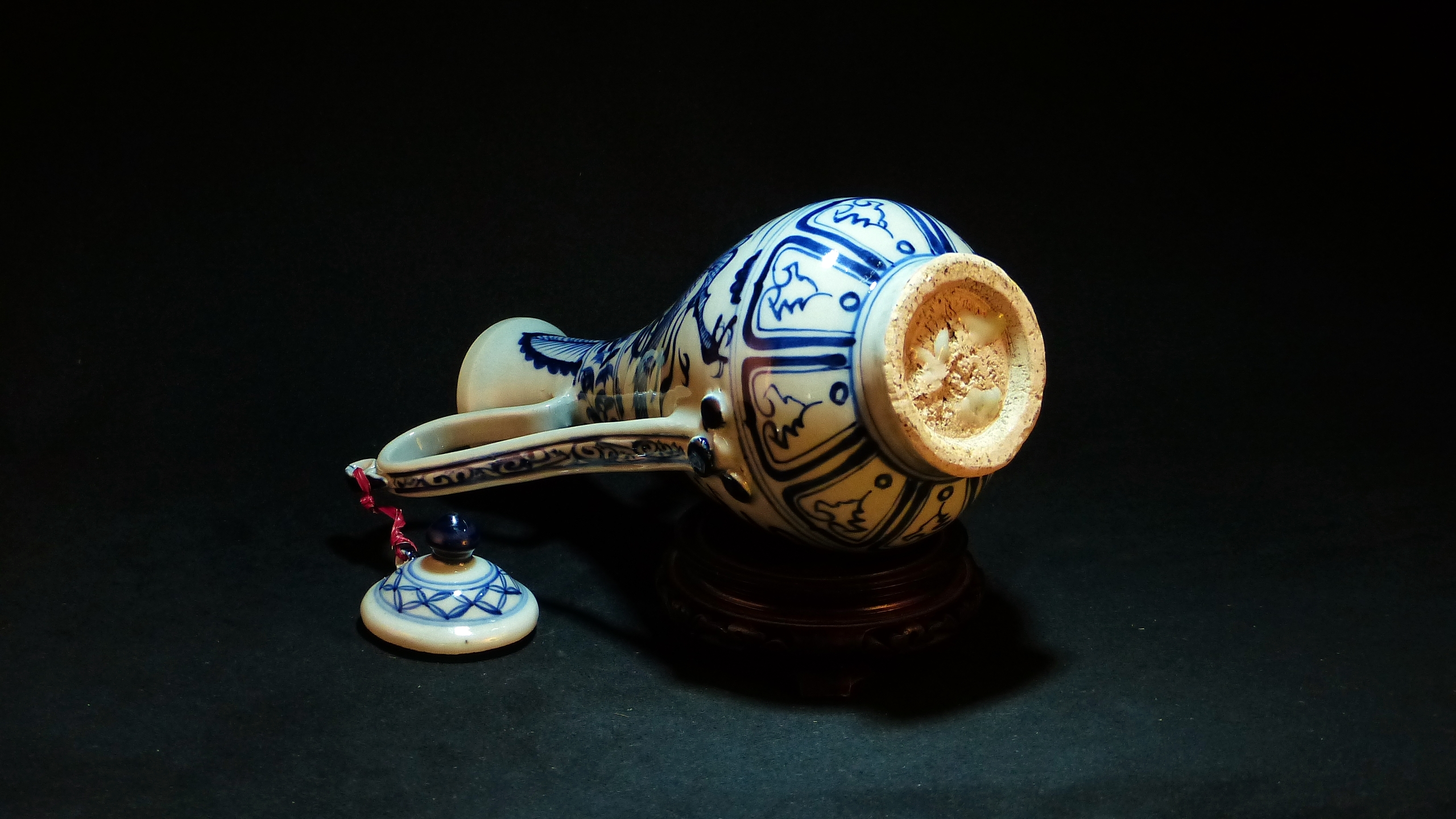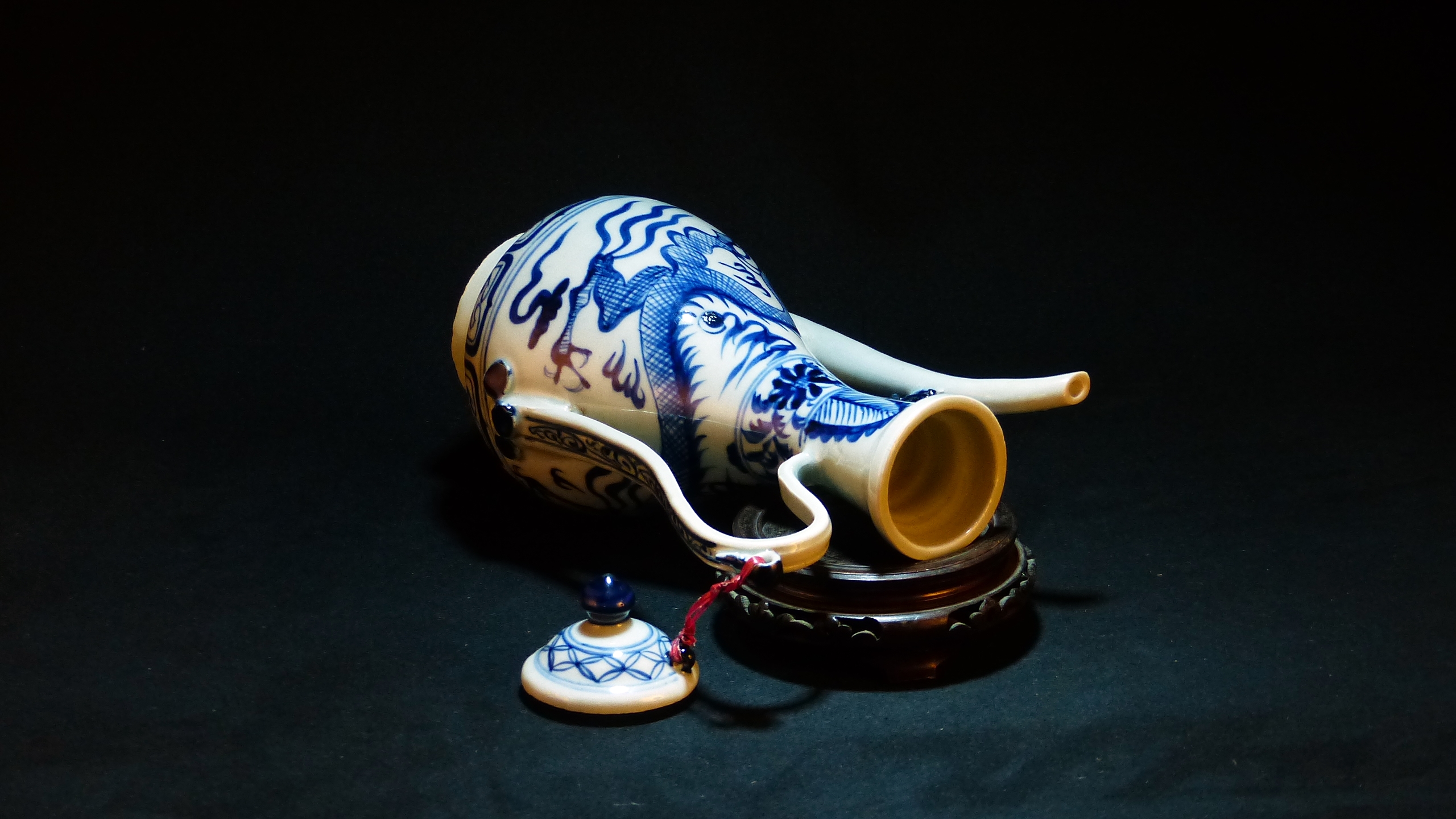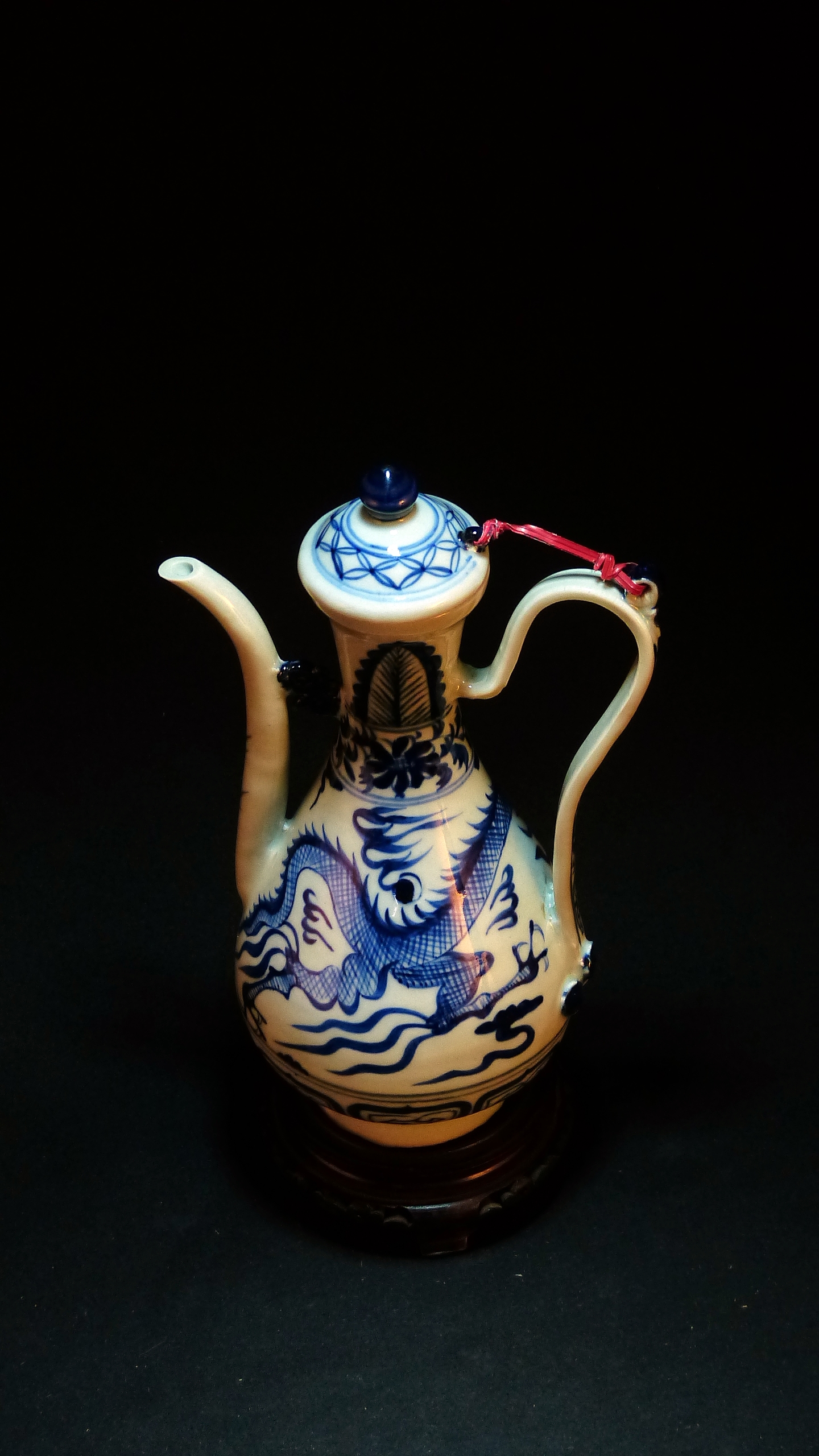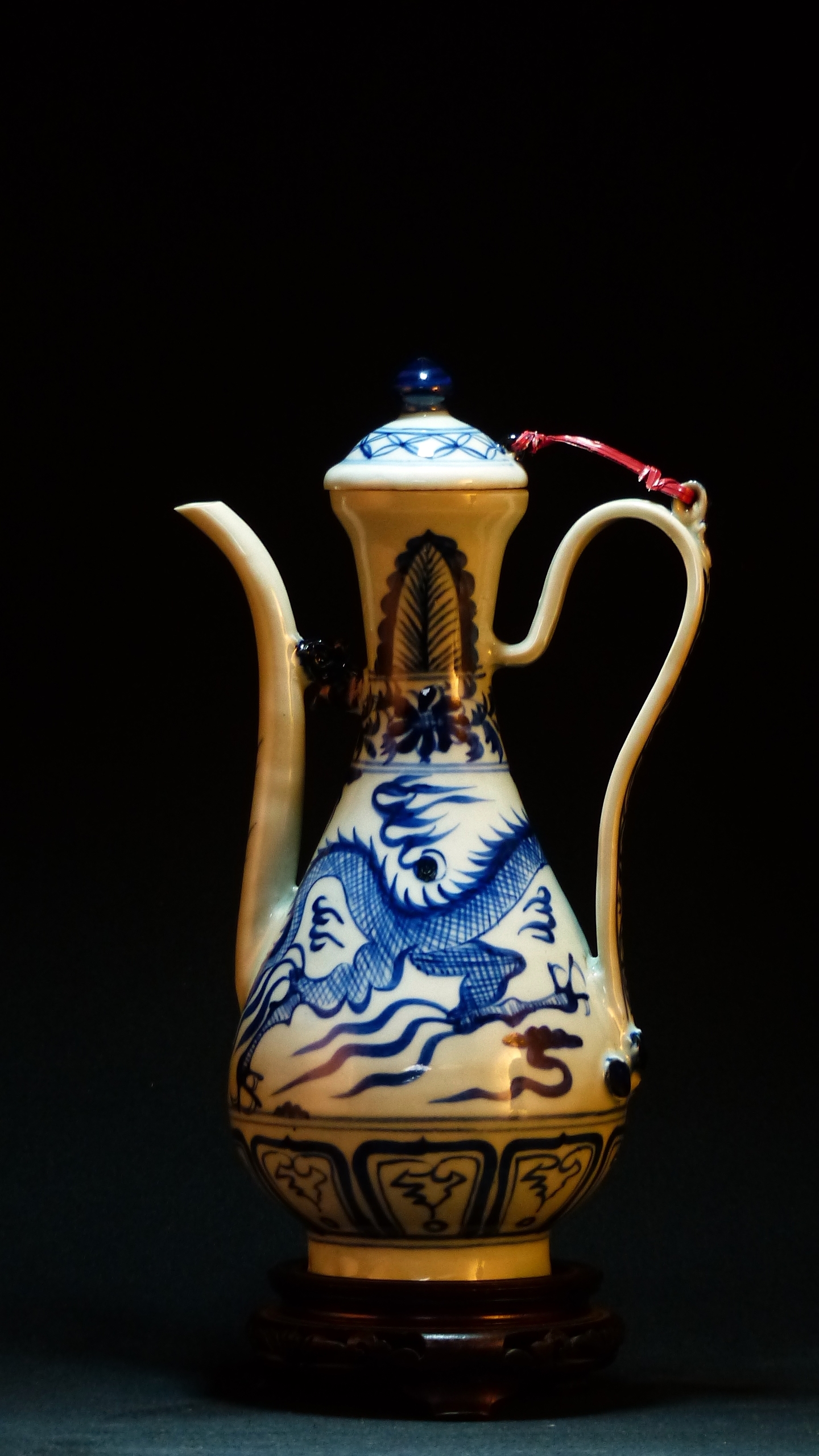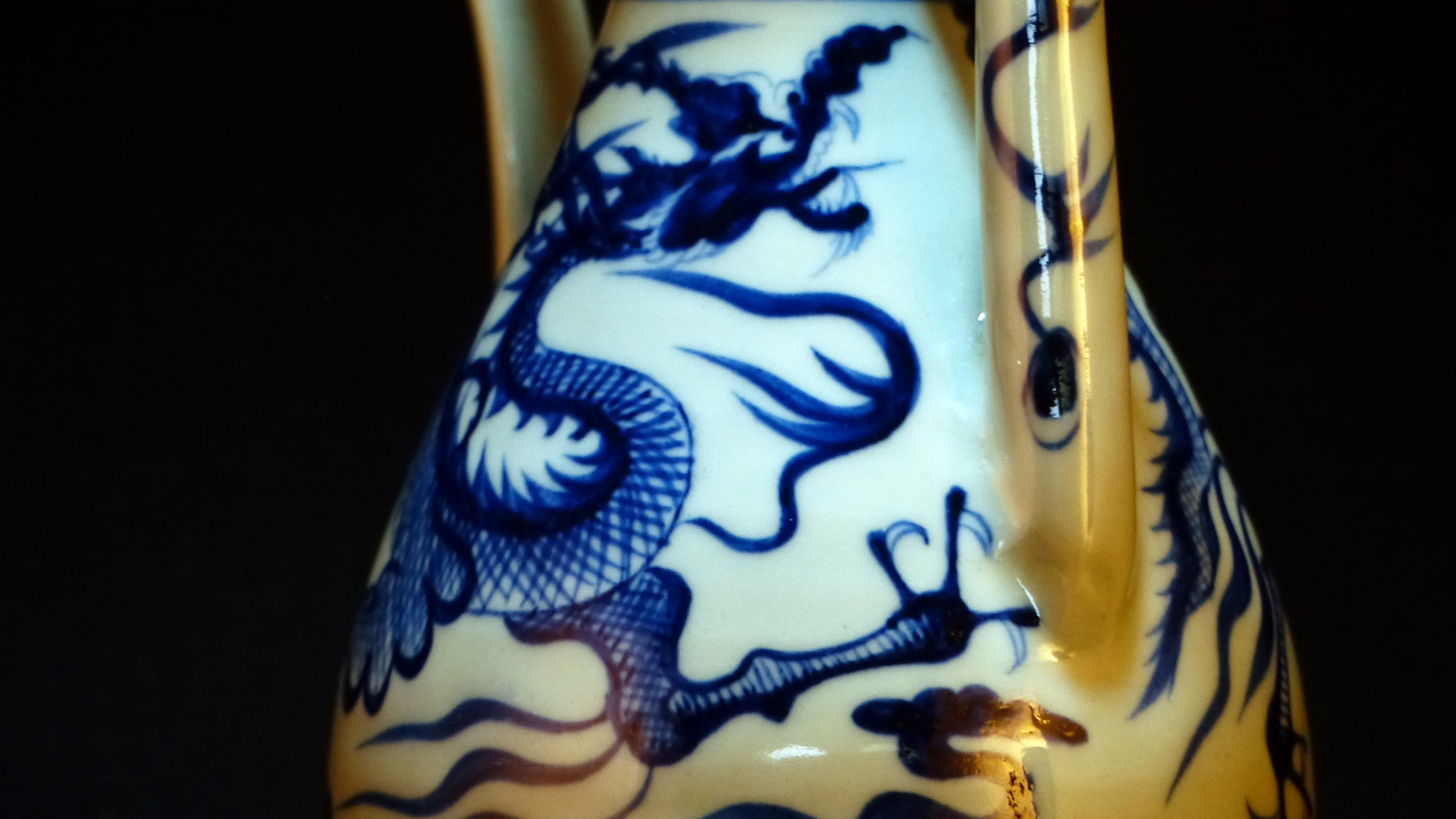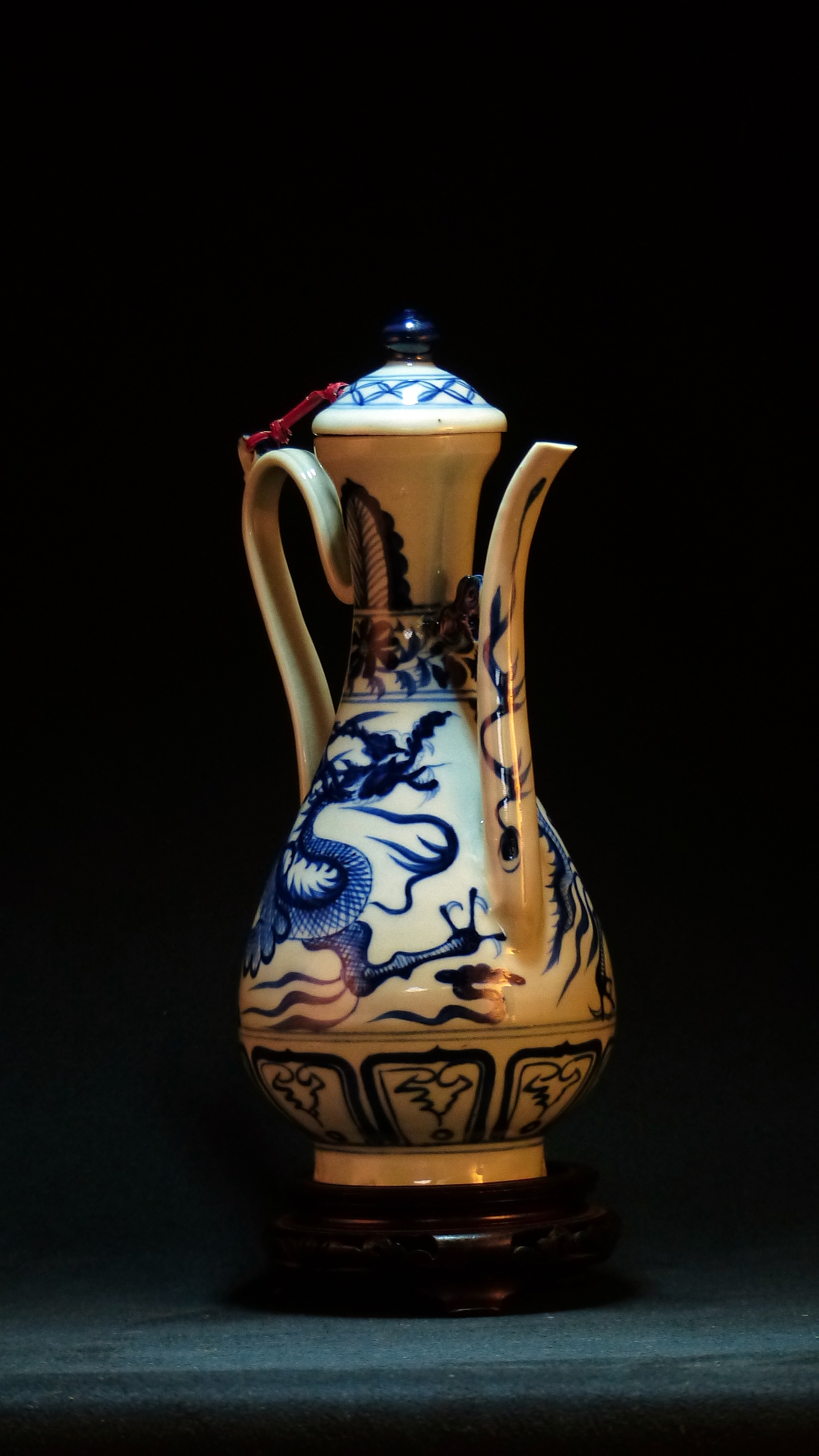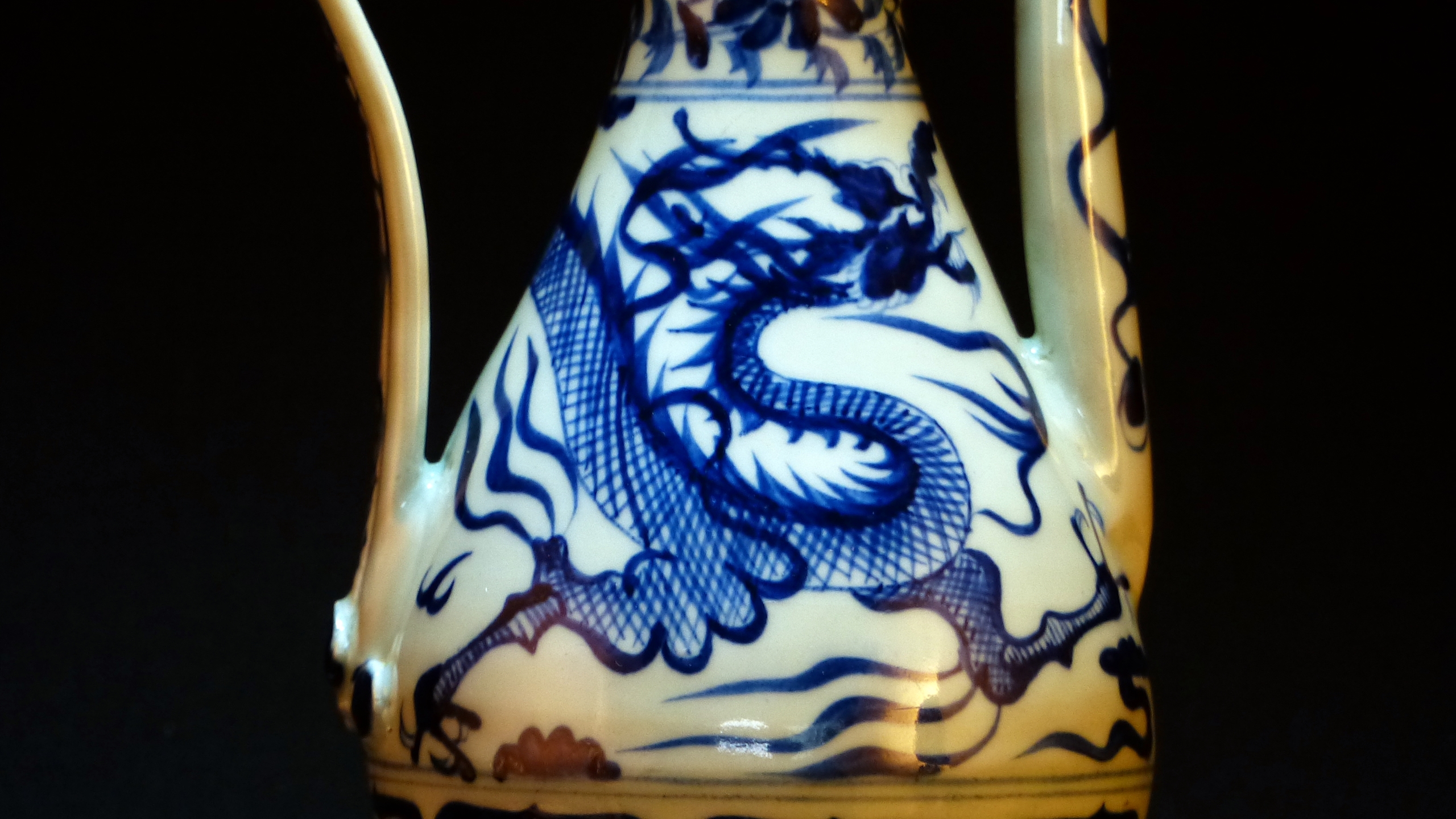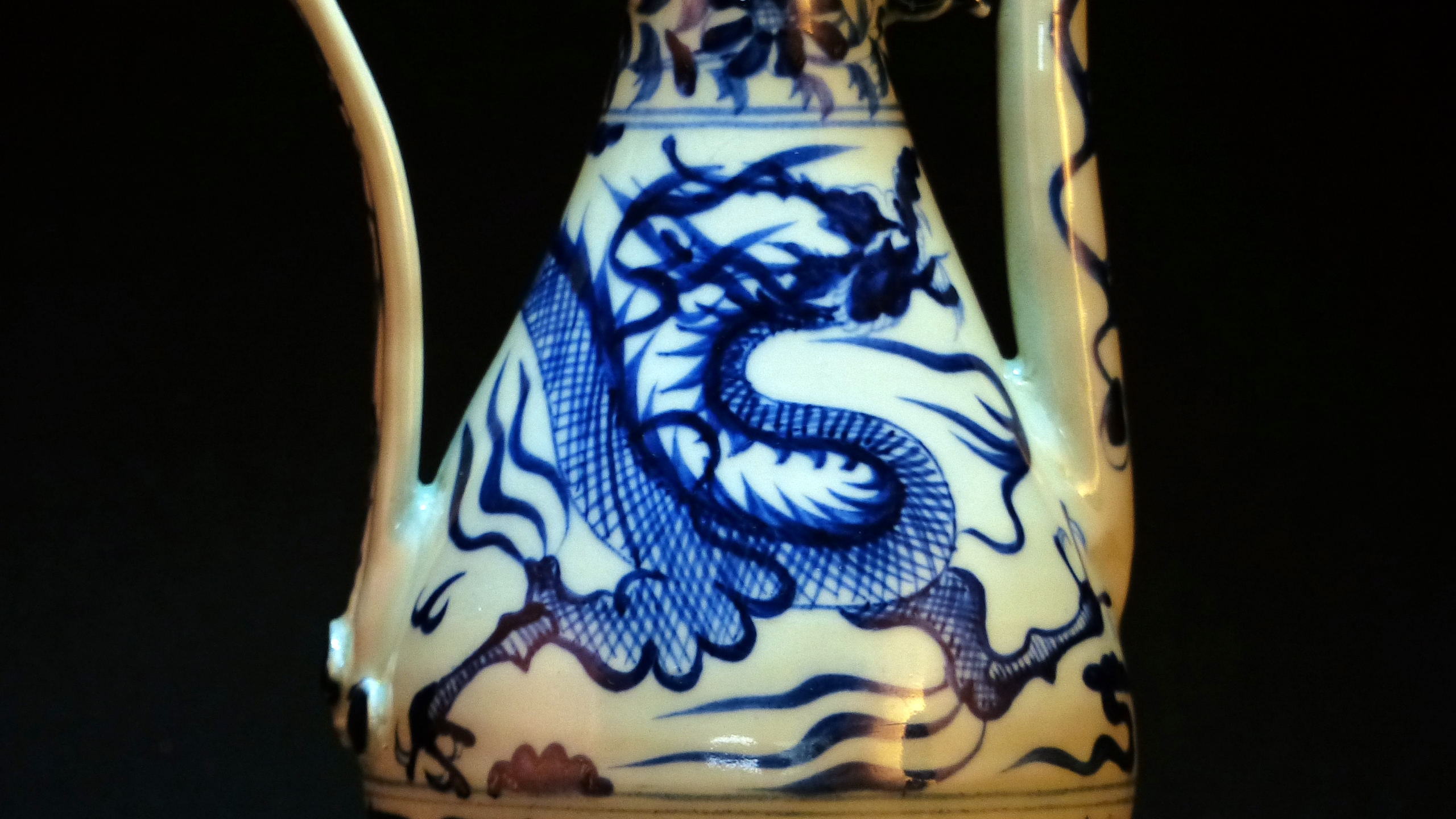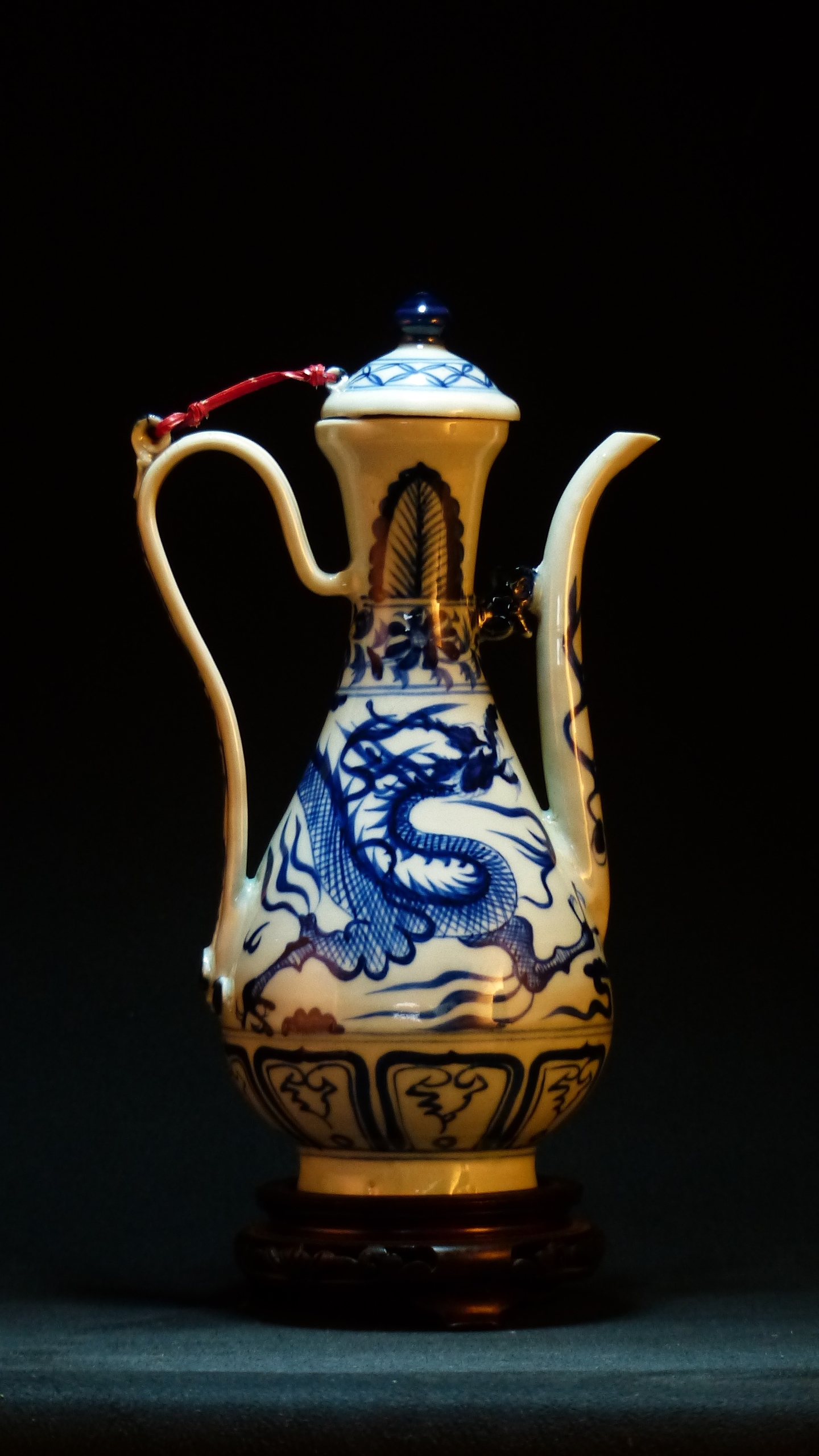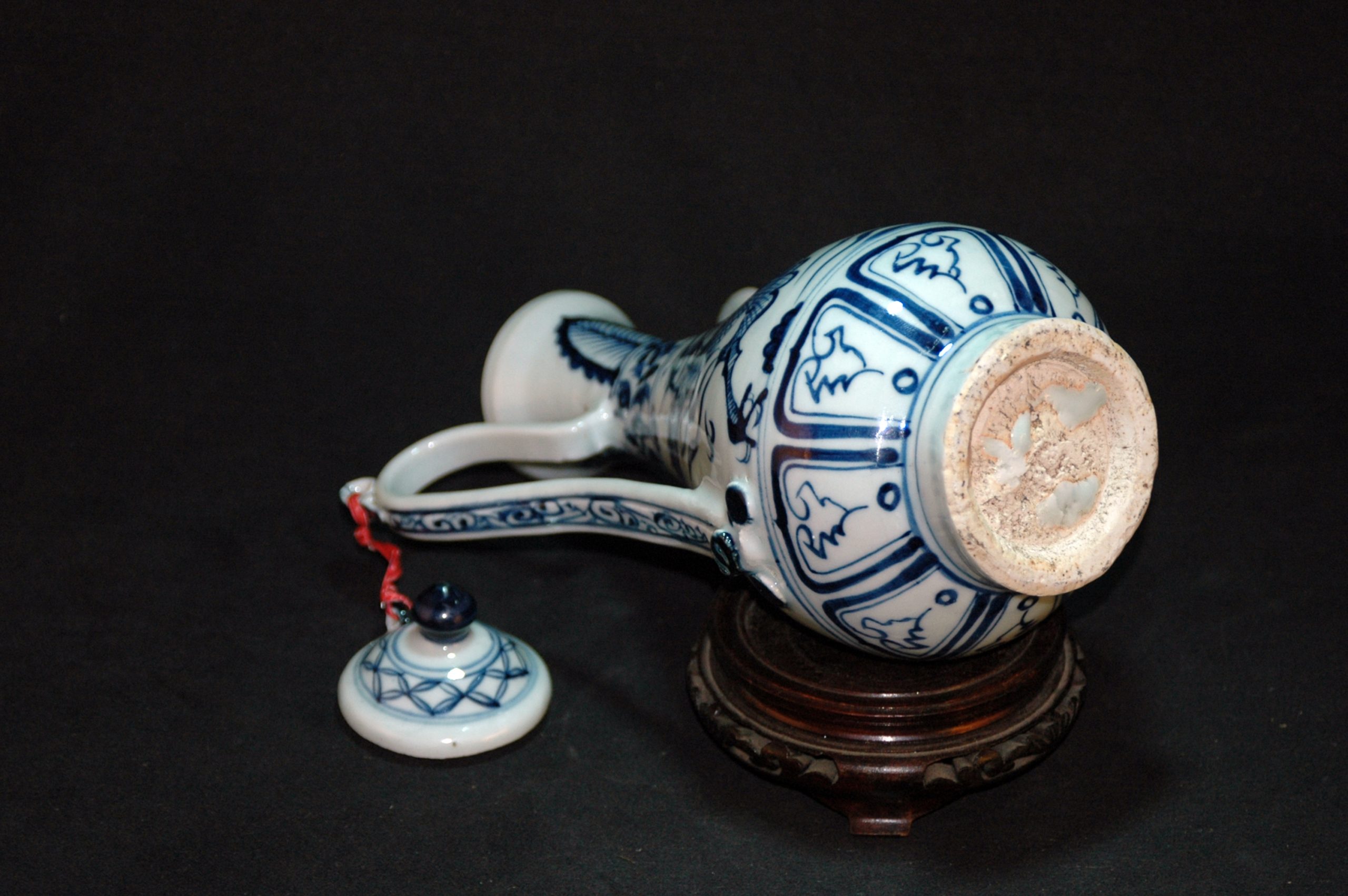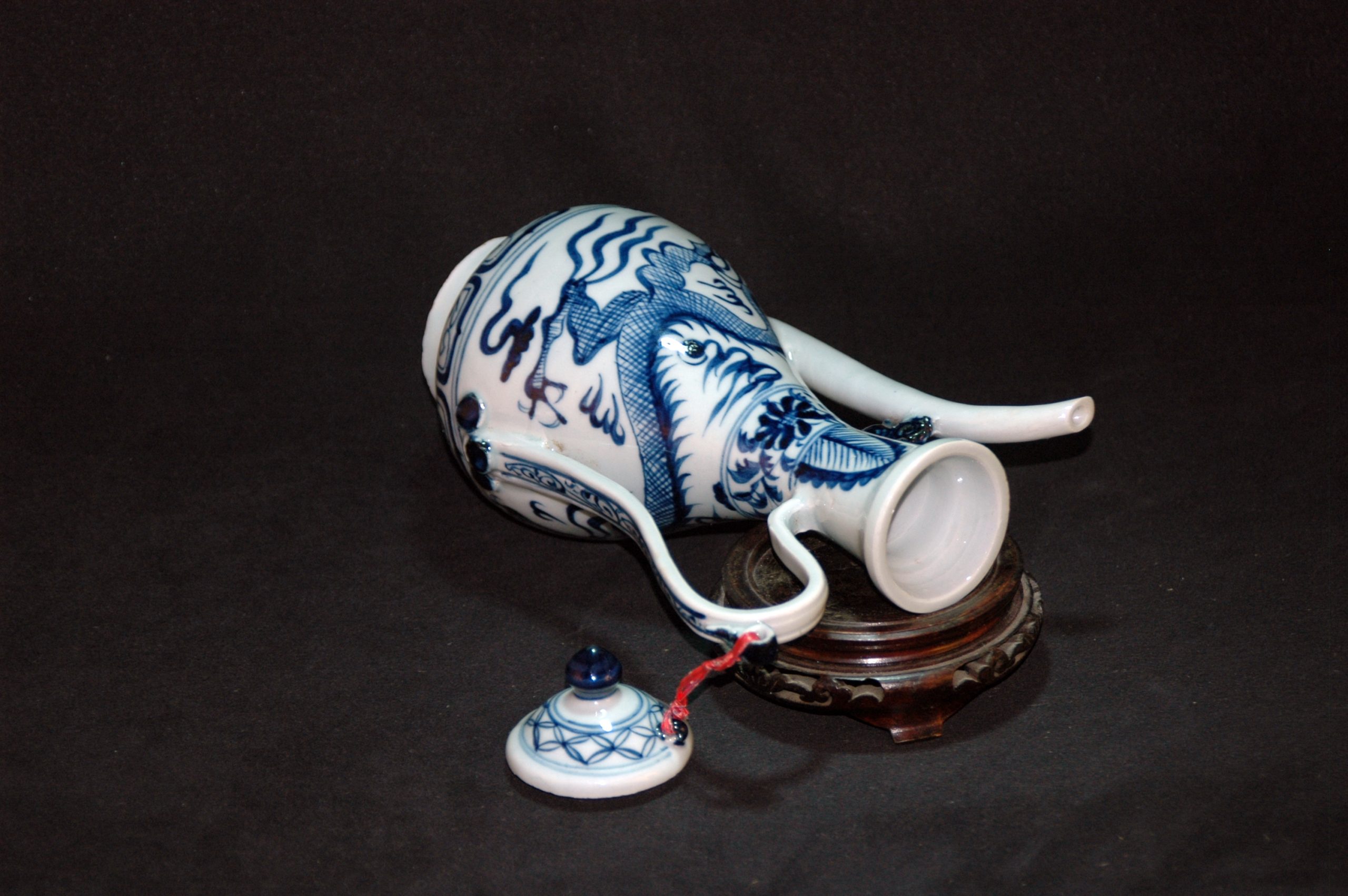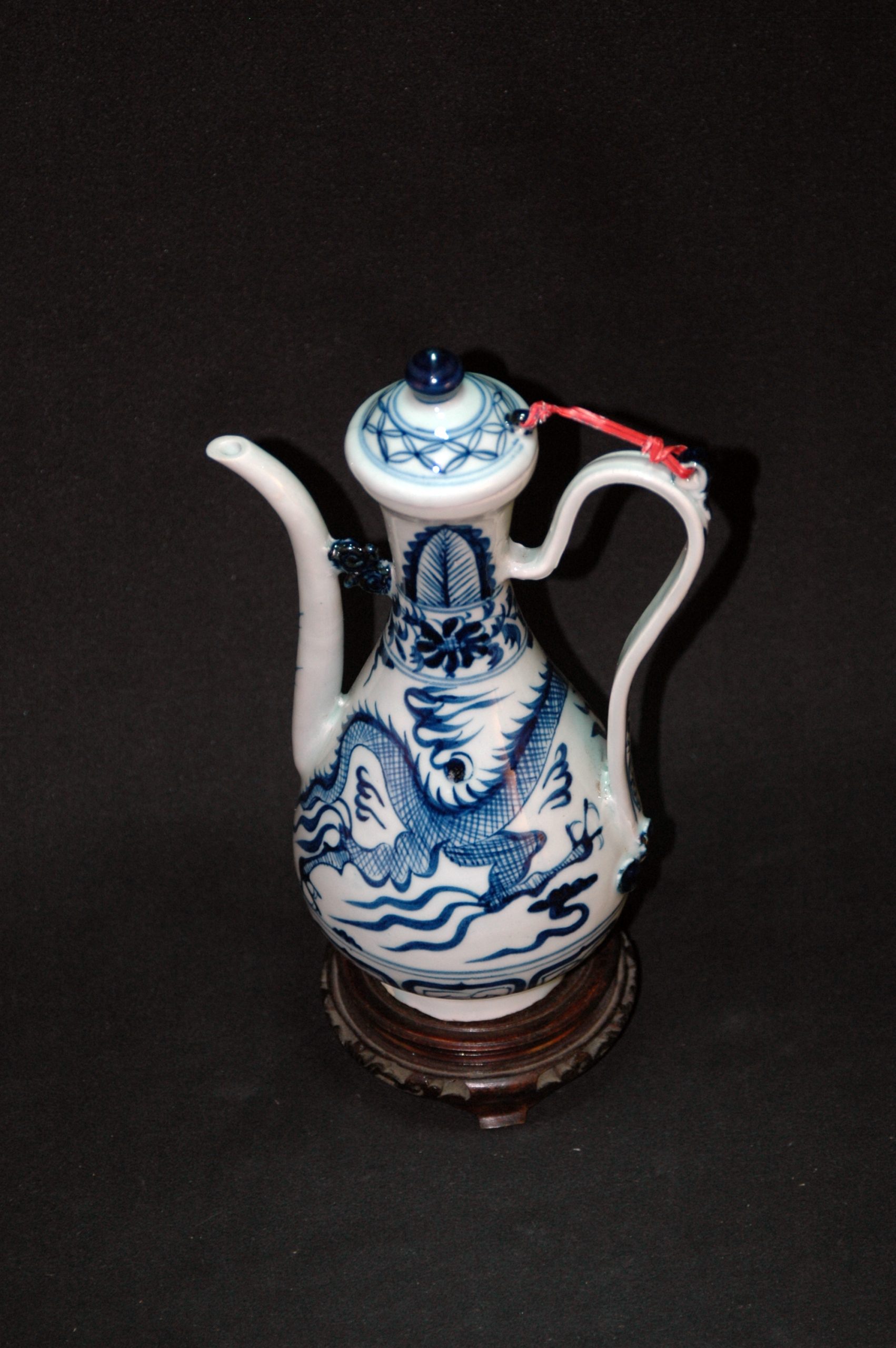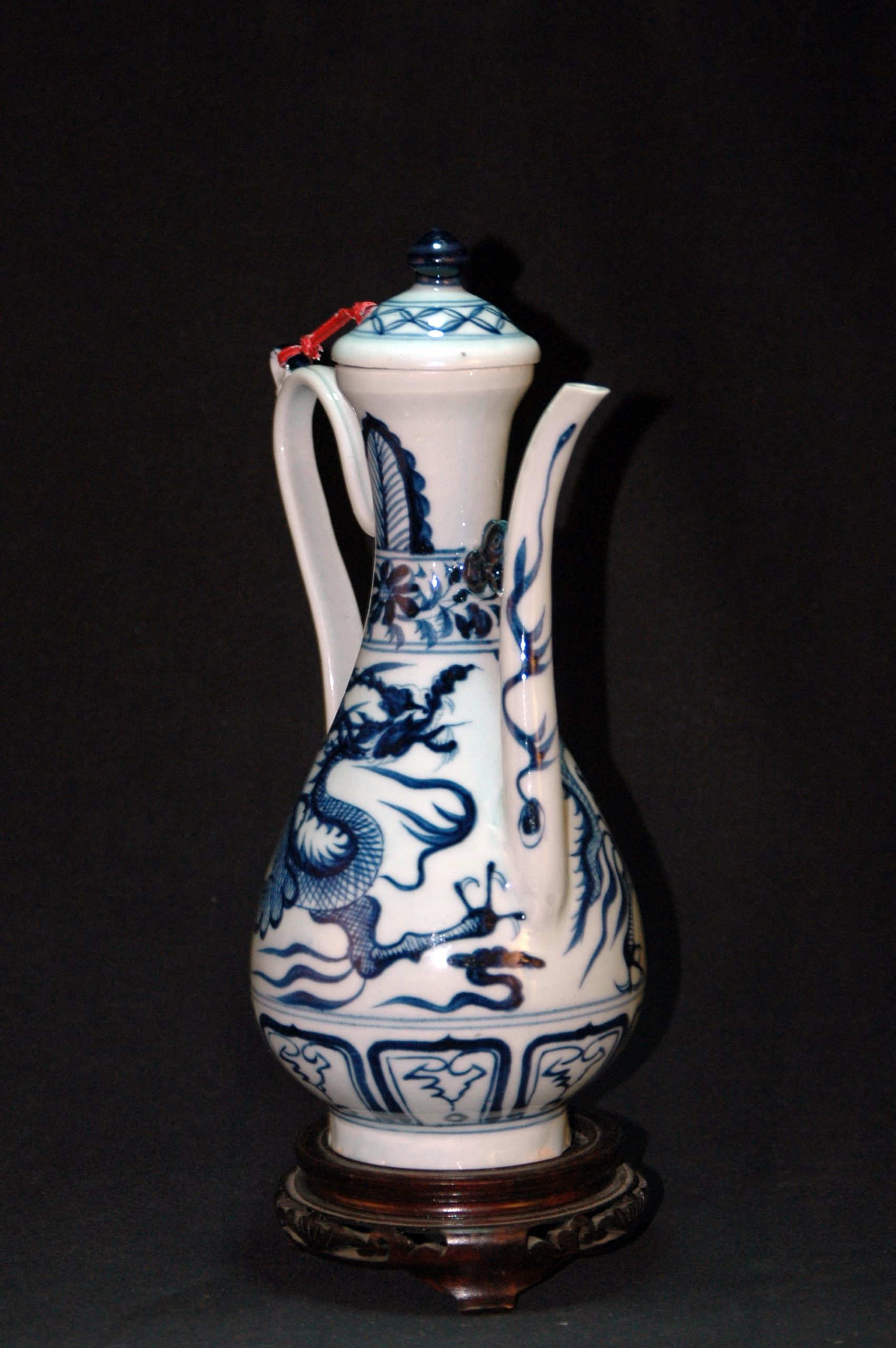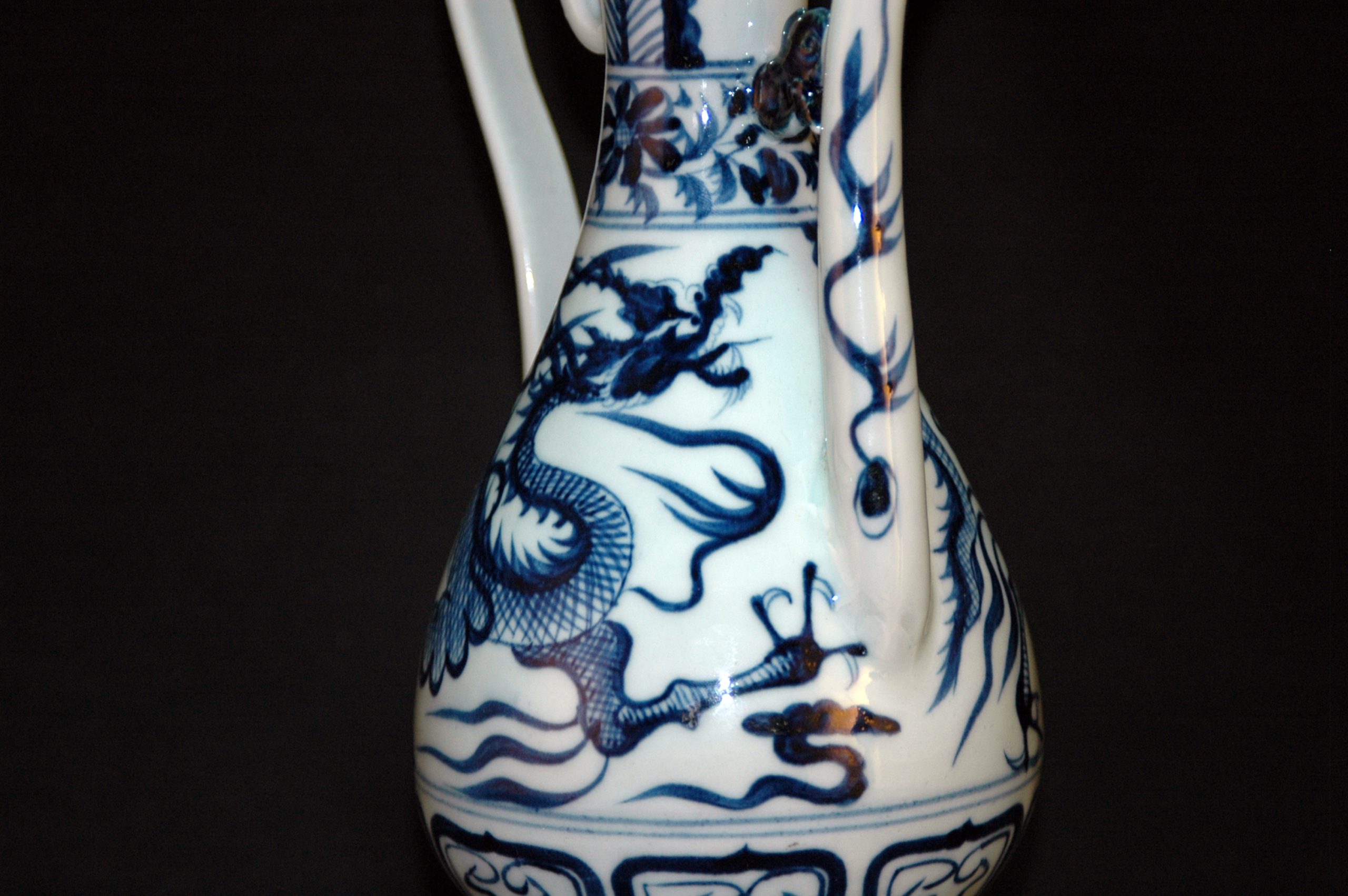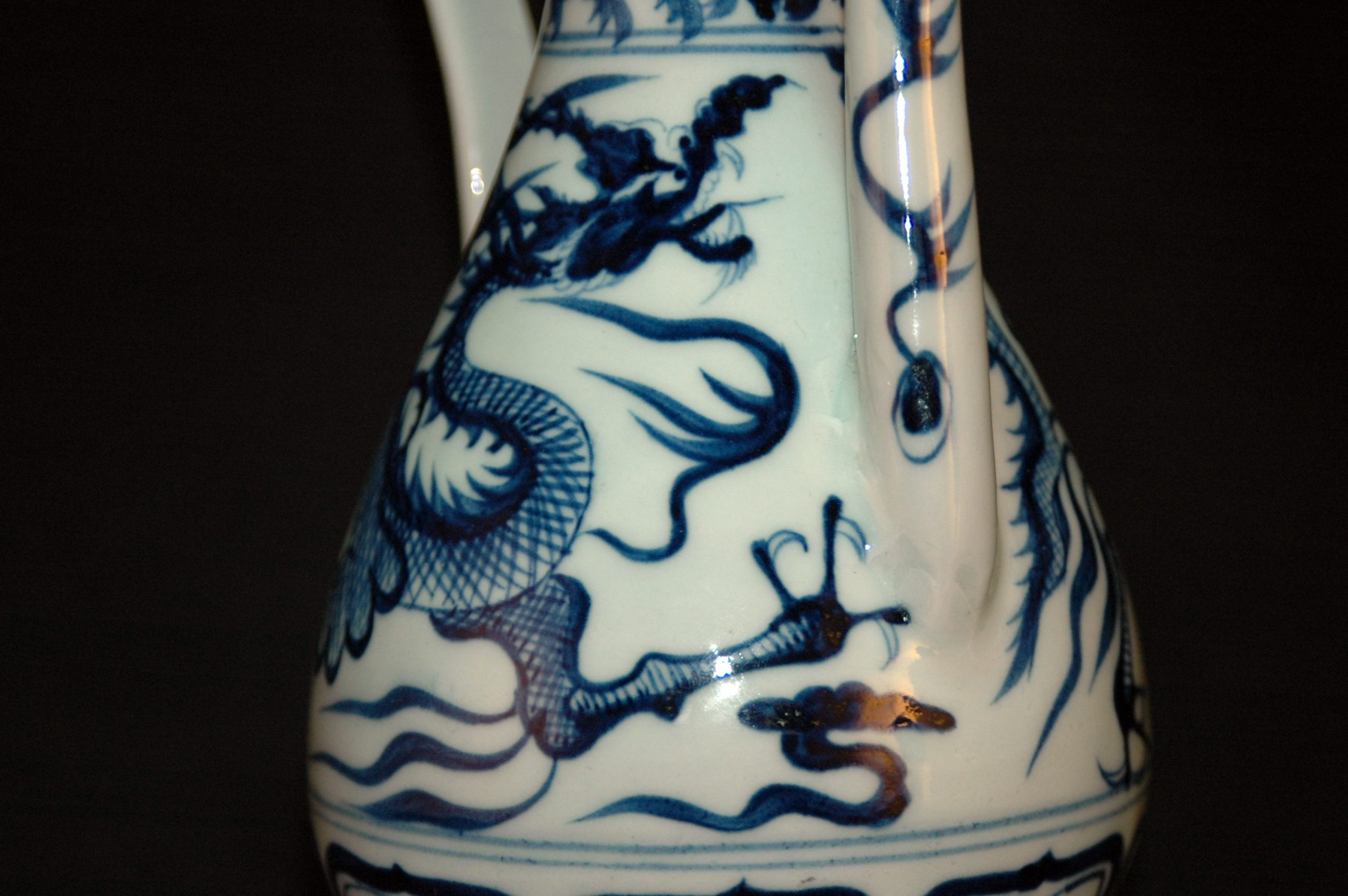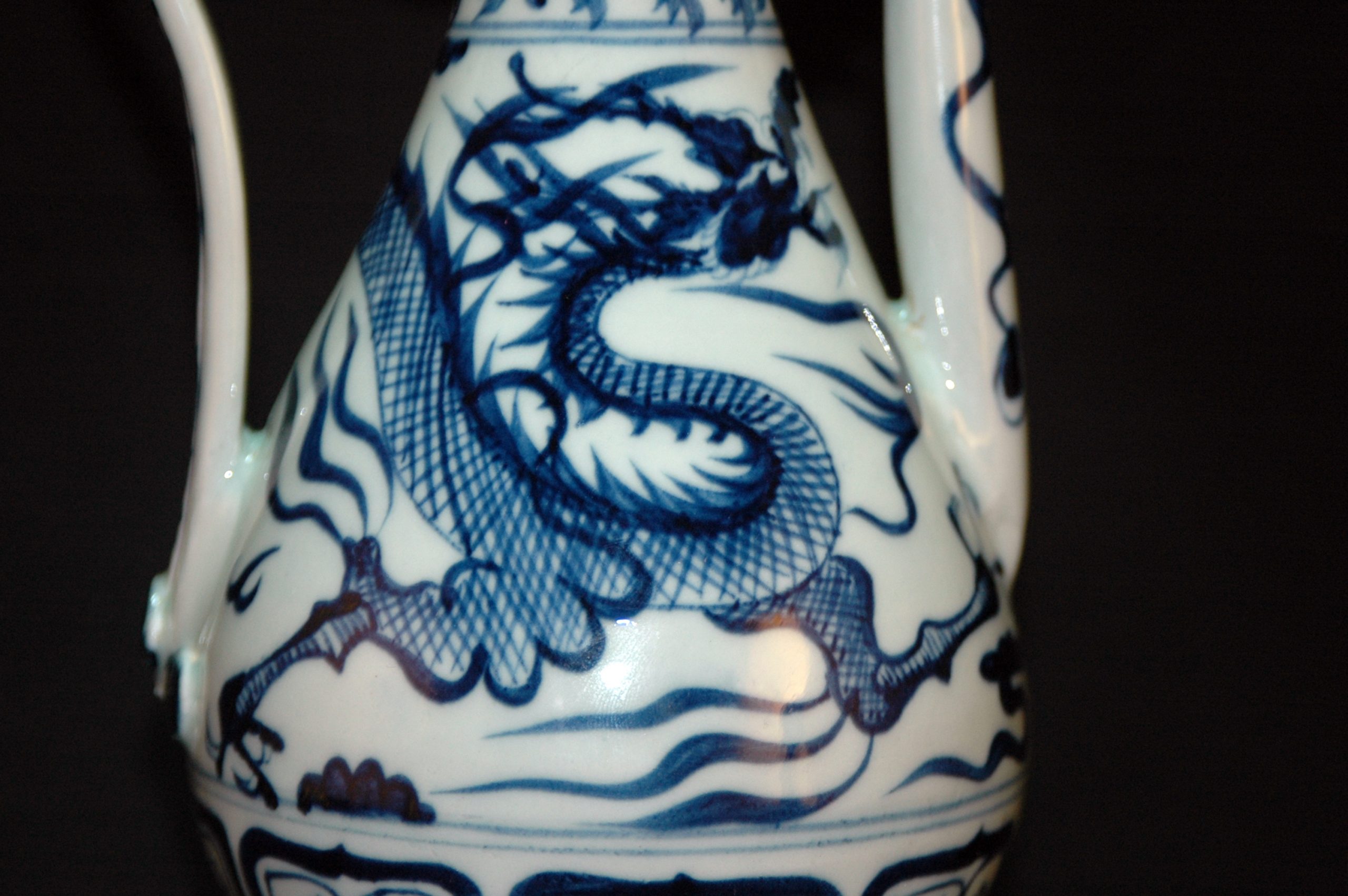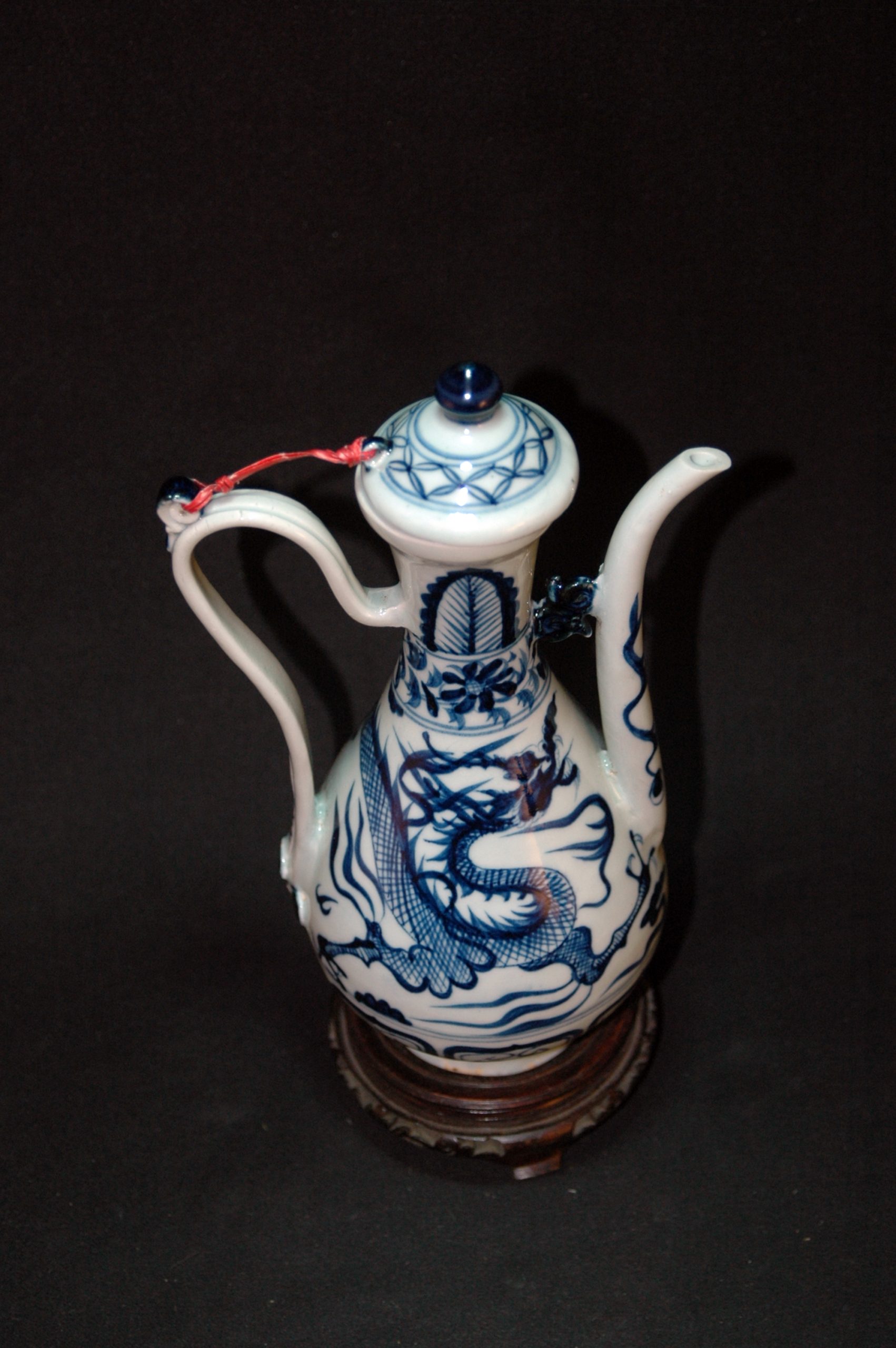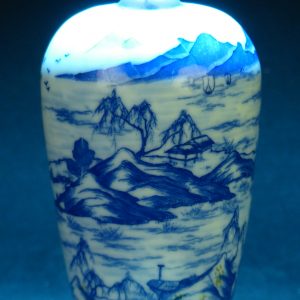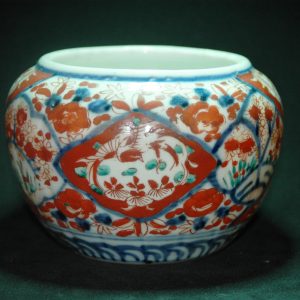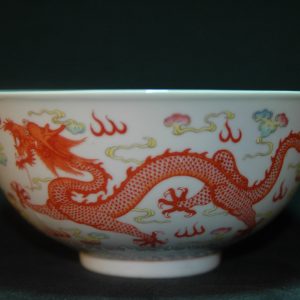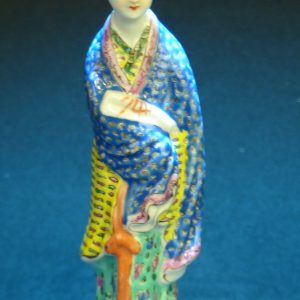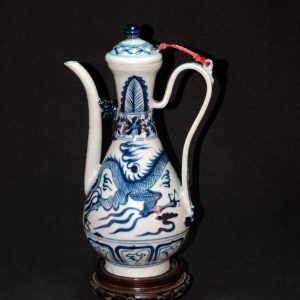Description
元 云龙纹青花执壶
伊朗国家博物馆—伊斯兰馆—中国青花瓷器
来自微博:悦目赏心de古风遗韵
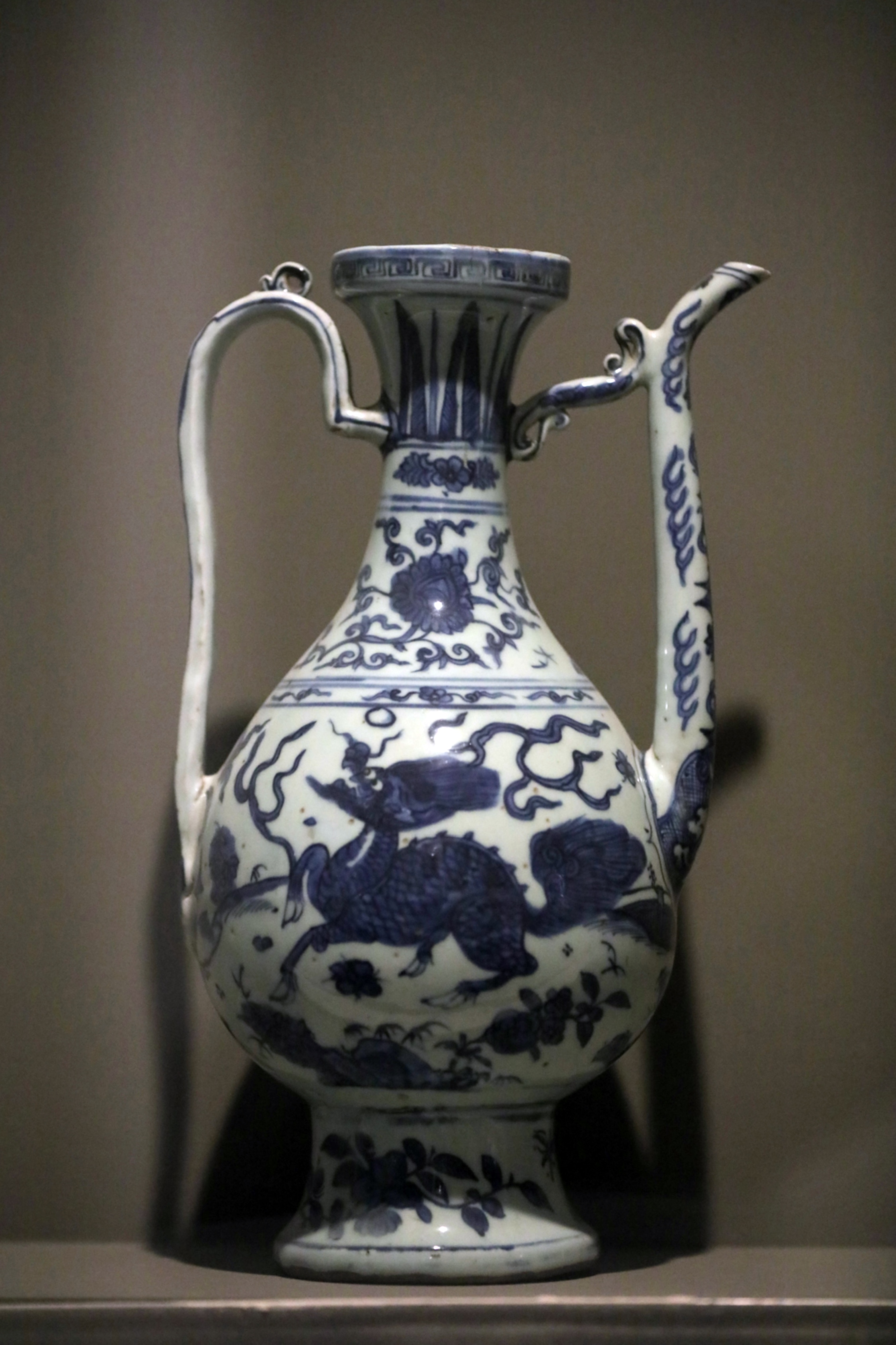
参考 :苏富比 283
中國藝術珍品
重要私人收藏中國瓷器
元 青花穿花鳳紋玉壺春瓶
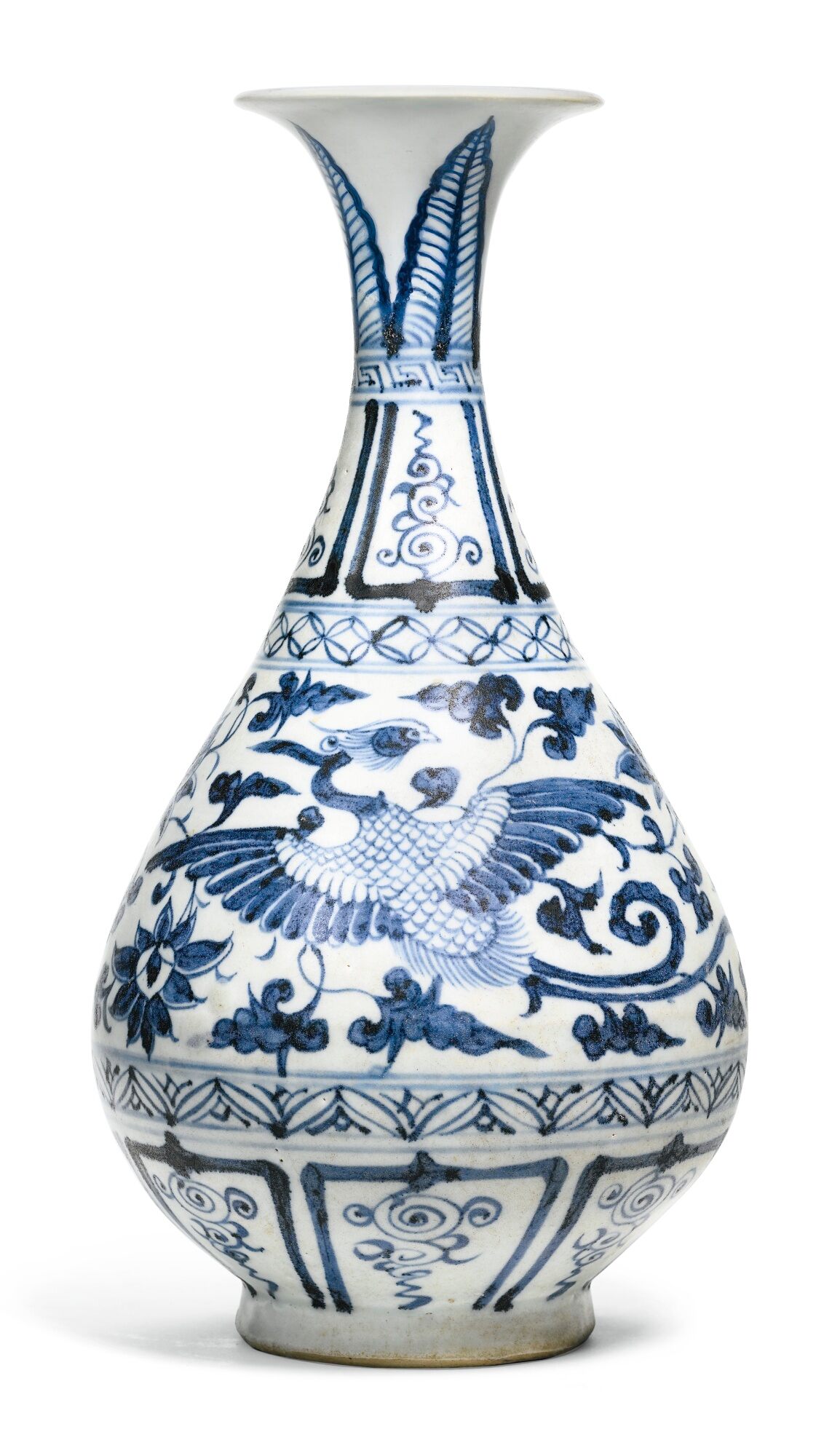
20,000 — 30,000英鎊
拍品已售 106,250 英鎊 成交價 (含買家佣金)
拍品詳情
元 青花穿花鳳紋玉壺春瓶
25.5公分, 10英寸
狀況報告
瓶頸上部(口沿對下5公分)有破損和修復。釉面有表面磨損。圈足有一些老磕損。
來源
倫敦蘇富比2001年11月14日,編號95
中國藝術珍品
2015年5月13日 | 上午 11:00 BST
倫敦
参考: 苏富比 37
靈逸博雅:井上恒一珍藏中國藝術
元 青花趕珠龍紋玉壺春瓶
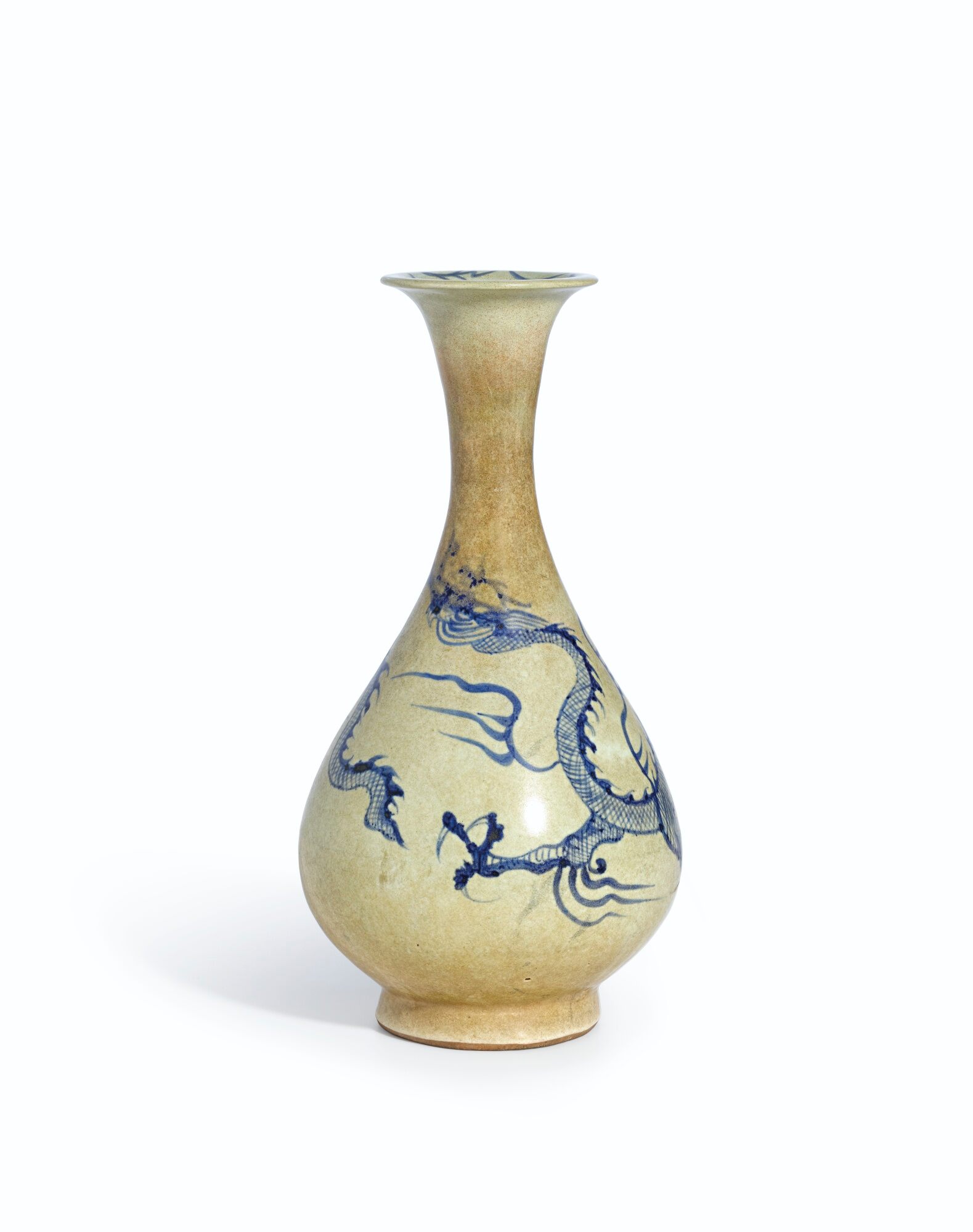
5,000 — 7,000英鎊
拍品已售 20,000 英鎊 成交價 (含買家佣金)
拍品詳情
元 青花趕珠龍紋玉壺春瓶
數量: 2
28.8公分, 11 3/8 英寸
狀況報告
口沿及器頸上端經修復。窰燒有誤使頸(龍頭部分)及下腹呈淺褐色。修足稍欠均勻。器體另有其它窰燒瑕疵如爆釉、細小縮釉‧黏砂及鏽斑。
來源
繭山龍泉堂,東京
平野古陶軒
展覽
《元明名品展》,日本陶磁協會(日本橋高島屋),東京,1956年,編號62
《中國宋元美術展》,東京國立博物館,東京,1961年,編號294
《中國陶磁名寶展》,五島美術館,東京,1966年
《中國美術展シリーズ宋元の美術》,大阪市立美術館,大阪,1978年,卷4,編號1~240
出版
奥田誠一、田中作太郎、広田不孤齋、林屋晴三(編),《中國の陶磁》,東京,1955年,編號237
藤岡了一,《元・明初の染付 陶器全集》,卷十一,東京,1960年,編號5
繭山龍泉堂,《龍泉集芳》,卷一,東京,1976年,圖版703
相關資料
比較一青花瓶例,上作三爪搶珠祥龍,出土自內蒙翁牛特旗梧桐花鄉,曾展於《Empires Beyond the Great Wall》, Natural History Museum of Los Angeles County,洛杉磯,1994年,編號 91;Charles Russell曾收藏兩例,一例後入安宅氏典藏,現存於大阪市立東洋陶磁美術館,大阪,曾展於《元の染付展—14世紀の景德鎮窯》,1985年,編號24,後售於倫敦蘇富比1936年2月12日,編號75;另一件後為Alfred Clark及玫茵堂收藏,後售於香港蘇富比2011年4月7日,編號38;另可參考一例,售於紐約蘇富比2005年3月31日至4月1日,編號101;亦可比較一瓶例,瓶足環飾回紋,售於香港蘇富比1998年4月28日,編號726。
河南滎陽縣曾出土一例,上飾五爪雲龍,現藏鄭州河南博物院,圖見葉佩蘭,《元代瓷器》,北京,1998年,圖版90B,並錄另一作例,現存中國國家博物館,北京,圖版 90A。
靈逸博雅:井上恒一珍藏中國藝術
2015年5月13日 | 上午 10:00 BST
倫敦
参考:苏富比 17
玫茵堂珍藏──
重要中國御瓷選萃之四
2012年10月9日 | 上午 11:15 HKT
香港
元十四世紀初至中葉 青花模印「遊龍爭珠」圖高足盃
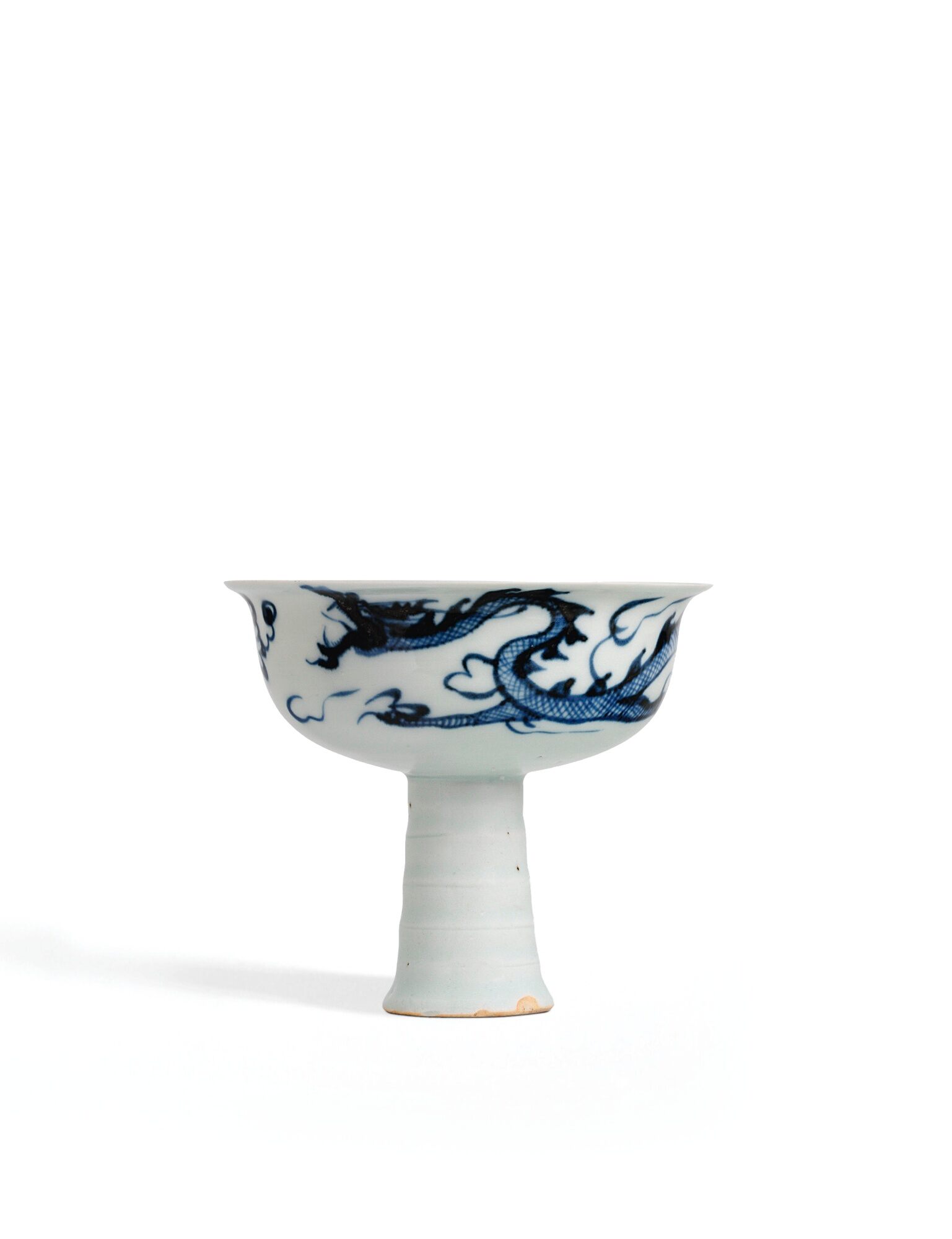
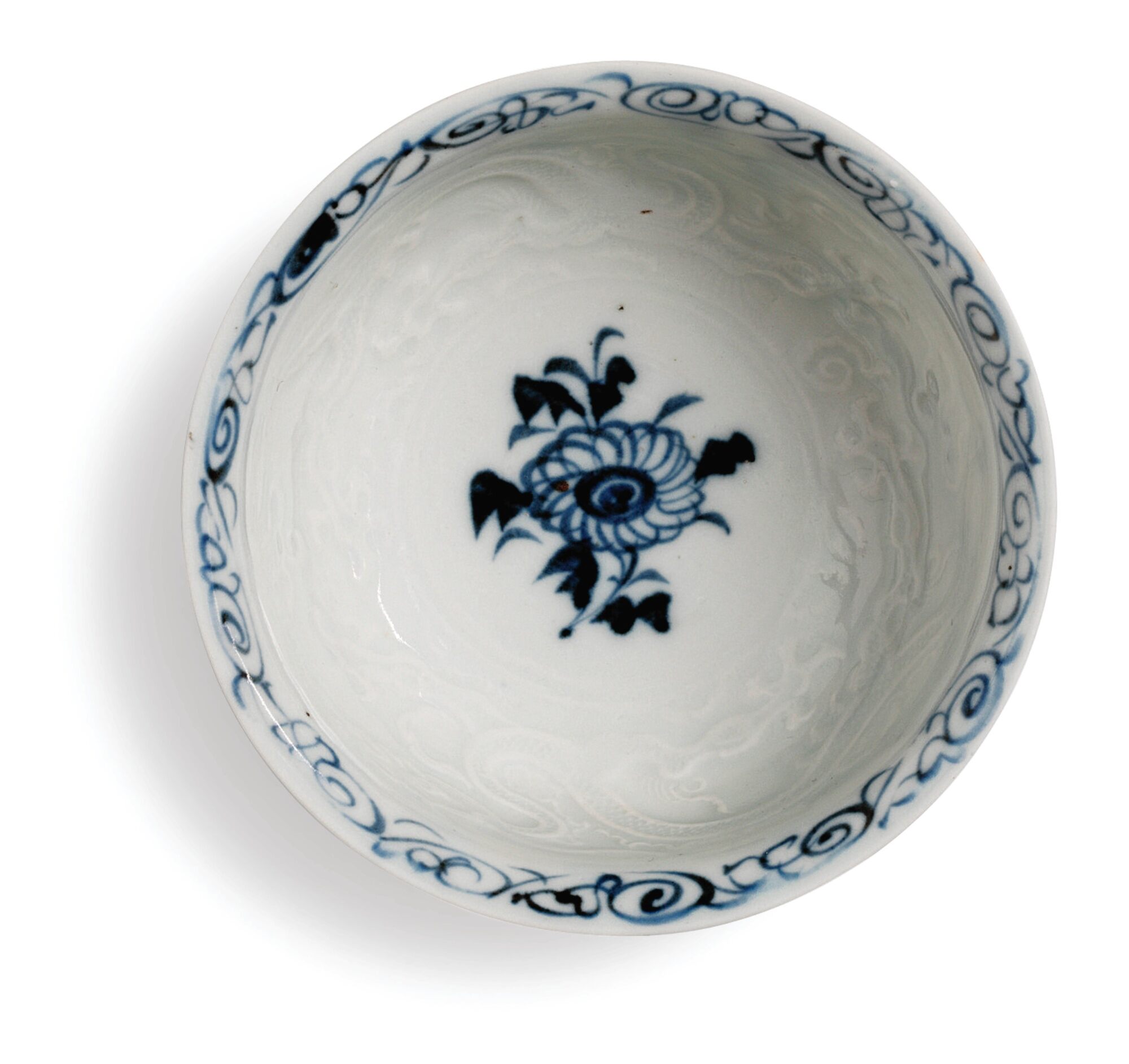
8,500,000 — 10,000,000港幣
拍品已售 12,420,000 港幣 成交價 (含買家佣金)
拍品詳情
元十四世紀初至中葉 青花模印「遊龍爭珠」圖高足盃
此為高估價拍賣品。蘇富比可要求有意競投高估價拍賣品的顧客填寫預先登記申請表及交付蘇富比港幣2,500,000元或其他由蘇富比決定之更大金額的訂金及任何財務狀況証明,擔保或/及其他由蘇富比全權酌情決定要求的抵押作為參加蘇富比競投的保障。即投BIDnow網上競投服務並不適用於高估價拍賣品。
圓弧壁,侈口,高足外撇,有竹節凸棱。盃心繪青花折枝菊花,內壁模印四爪逐珠游龍成雙,一龍前方有「玉」字,口沿綴青花捲草紋一周。盃外另畫青花三爪行龍,張嘴欲噬火珠。圈足內無釉。
徑 11.5 公分,4 1/2 英寸
狀況報告
There is an old original minute 6 mm. flake in the glaze by the foot ring and another minute nick next to it. There are some pinholes and expected minor firing imperfections in the glaze, but overall the stemcup is in very good condition.
來源
山中商會(1940年1月, £ 38)
R.H.R. Palmer(1898-1970年)收藏(編號 539)
香港佳士得1989年1月17日,編號561
香港徐氏藝術館藏品(靜觀堂)
香港佳士得1996年11月3日,編號542
展覽
《歷代文物萃珍:敏求精舍三十週年紀念展》,香港,1990-91年,編號121
出版
Harry Garner 爵士,《Oriental Blue and White》,倫敦,1954年,圖版2A
E.E. Bluett,〈Chinese Works of Art in English Collections: The Collection of Mr. and Mrs. R.H.R. Palmer〉,第1部分,《Apollo》,1958年4月,頁160,圖VIII (c)
《徐氏藝術館》,香港,1991年,圖版57
康蕊君,《玫茵堂中國陶瓷》,倫敦,1994-2010年,卷4,編號1619
相關資料
高足盃形,繪遊龍爭珠,龍體雄健,畫意率真,見於蒙元一代。類例罕見,相若瓷盃,有飾龍或鳳紋者,出土於內蒙古元代集寧路古城遺址,參考一龍紋高足盃,見陳永志編,《內蒙古集寧路古城遺址出土瓷器》,北京,2004年,圖版46,或三件鳳紋高足盃,見圖版42-4,亦有見數盃出土時整齊置於一甕罐內,參見頁12。前述之龍紋高足盃後入展於2009年北京首都博物館之《元青花》展覽,編號107,同展另一相類作例,則出土於安徽一處元代窖藏,見編號106。明洪武四年(1371)汪興祖墓出土物,也可資比對,該器現藏南京博物院,載於汪慶正,《青花釉裏紅》,香港,1993年,圖版33。
大英博物館另藏一例,錄於 Jessica Harrison-Hall,《Ming Ceramics in the British Museum》,倫敦,2001年,編號1:24。還有兩件相若器例,分別屬 O. Harriman 夫人及 Cunliffe 勛爵典藏,曾於1953-4年東方陶瓷學會假倫敦 The Arts Council Gallery 舉行之《Chinese Blue and White Porcelain: 14th to 19th Centuries》特展中展出,編號11及12。
参考: 佳士得 拍賣 2832
重要中國瓷器及工藝精品
香港|2010年12月1日
拍品3109 元 襄金属青花 壶
A VERY RARE GILT-METAL-MOUNTED BLUE AND WHITE OCTAGONAL EWER
YUAN DYNASTY (1279-1368)
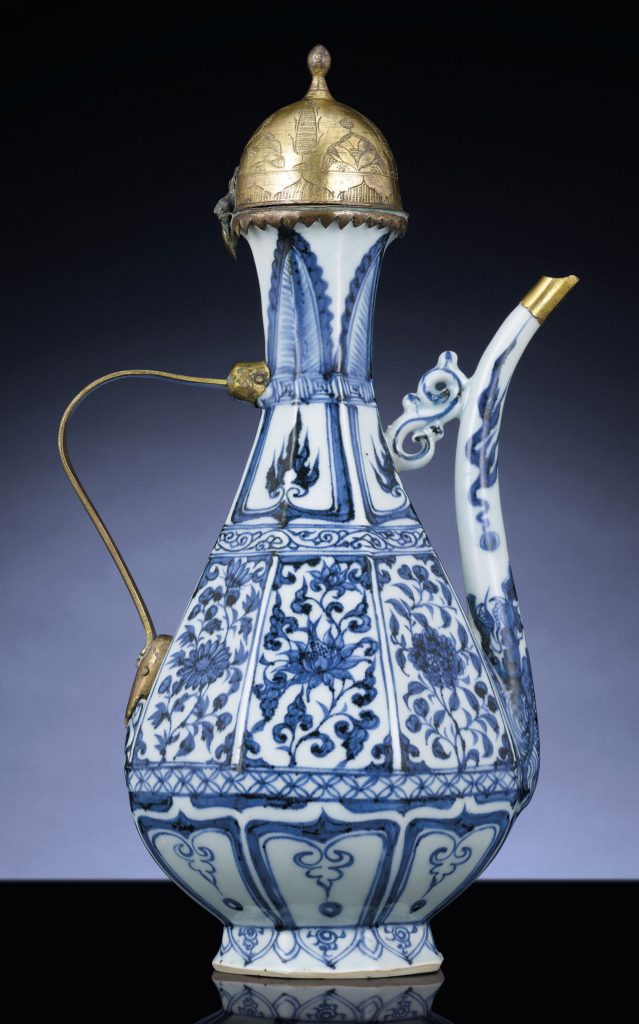
成交總額
HKD 5,060,000
估價
HKD 2,500,000 – HKD 3,500,000
元 青花花卉紋八方執壼
無論是以形制大小或紋飾畫工而言,是次拍賣的八方執壼皆非凡品。這類帶棱面的設計,在元代青花瓷及龍泉窰青瓷中較為常見。此類器物大行其道,或是因為當時中土對西亞(如伊朗、敘利亞及馬穆魯克時代的埃及)金屬器的喜愛,或得益於唐代金屬器再度流行,學者多持前一種見解,詳見M. Medley所著《Metalwork and Chinese Ceramics》大維德中國藝術館專論系列之二第14頁(倫敦:1972)。至於部分唐代器物所採用的棱面樣式,很可能是與中亞及西亞進行文化交流的產物。就此而言,最著名的例子是勿里洞島沉船貨物及何家村窖藏文物中的八棱金盃,詳見蘇玫瑰於《東方陶瓷學會會刊》2002-3年67號刊20-22頁發表的〈A Remarkable Tang Dynasty Cargo〉。雖然宋代偶有燒造棱面器物,如浙江省博物館藏北宋初年龍泉窰青釉執壼,圖見《龍泉窰青瓷》第87頁編號46(台北:1998),但元代棱面瓷器顯然更為多樣化。元代龍泉窰瓷器最廣為人知的當屬八方梅瓶,大維德中國藝術館藏一例,載於蘇玫瑰《Imperial Taste – Chinese Ceramics from thePercival David Foundation》第48-9頁編號23(三藩市:1989)。其實,元代龍泉窰亦有燒造棱面盤盌和粗頸梨形的瓷瓶,就此請參見前述著作《龍泉窰青瓷》第232-3頁編號214及215、第215頁編號195及第152頁編號119。
傳世的元代棱面青花瓷(多為八棱)不多,其中泰半為立式器物。伊斯坦布爾的托普卡比.薩雷博物館藏一件八方葫蘆瓶,其攢尖開光內繪昆蟲花卉,圖見《Treasures from Topkapi Palace – the Ceramics the Sultans loved》第20頁圖例11(九州陶磁文化館,1995);另一例為花鳥紋八方葫蘆瓶,載於朱裕平所著《元代青花瓷》第139頁圖例6-15(上海:2000);日本山形縣菊水工藝館(Kikusui Kogeikan Museum)亦珍藏一例,飾昆蟲、飛鳥和花草,收錄於朱裕平前述著作第47頁圖例2-16。另一例近似的八方葫蘆瓶源於伊朗阿德比爾珍藏,現已納入德黑蘭伊朗古代博物館,其瓶身下半部的圖樣載於J. A.Pope所著《Chinese Porcelains from the Ardebil Shrine》圖版27編號29.510(倫敦:1981年版)。
北京首都博物館近來展出了一批精采絕倫的元代青花瓷,當中囊括了數件棱面器物(詳見2009年北京出版的圖錄《元青花》):一例是遼寧博物館藏歲寒三友圖八棱罐(請見前述著作第54-7頁),另一例是1964年河北省保定出土窖藏文物中著名的海水白龍紋八棱梅瓶(前述著作第13頁),2006年河北墓葬出土文物中亦有一件近似梅瓶(前述著作第14頁)。傳世品中尚有二例八方梅瓶,其一為托普卡比.薩雷博物館珍藏(圖見前述著作《Treasures from Topkapi Palace – the Ceramics the Sultans loved》第21頁圖例12),其二源自東京松岡美術館(圖見前述《元代青花瓷》第128頁圖例5-16)。2004年,安徽省出土了一件極為罕見的象耳八方瓶,此器亦曾亮相於首都博物館展覽(載於前述著作《元青花》第41頁)。
最常見的元青花八棱器形為「玉壼春瓶」。首都博物館曾展出保定窖藏文物中的祥獅紋玉春瓶(圖見前述《元青花》第32-4頁),朱裕平所著《元代青花瓷》亦收錄四例,載於第97頁圖例4-12及第138頁圖例6-12-14。東京梅沢記念館亦珍藏一例,其畫工之精絕與本拍品不相上下,圖見三上次男所著《世界陶瓷全集》卷十三之「遼金元」圖版207(東京:1981)。
像本拍品這一類的青花玉春瓶式八方執壼,在近似例中極為罕見。1964年,保定出土窖藏文物中有一件器型略小但紋飾相若(其筆觸較豪邁寫意)的近似例,首都博物館曾展出此器(前述《元青花》第70-1頁)。香港蘇富比於1987年11月24日拍出一例形制相同但較小的青花執壼,其紋飾較為繁縟,現已納入東京松岡美術館珍藏(載於《Toyo Toji Meihin Toroku》圖版61(東京:1991)。此外,J. Carswell所著《Blue and White: Chinese Porcelain Around the World》卷首插圖亦載有一近似例(倫敦:2000)。本拍品的流口根部所繪龍首張口怒目,作銜流狀,其布局在近似例中少之又少。此類獸首多以立體形象出現於白釉執的流底,間或也用於裝飾柄(就此可參見三上次男前述著作《世界陶瓷全集》卷十三之「遼金元」圖版42),像本執壼般繪於流底者極罕。
本拍品配有鎏金銅流尖、鉸蓋及柄,其風格極具十七或十八世紀奧斯曼帝國的特色。流尖及柄可能是原件散失後所添置,若原蓋乃瓷製品,用鉸蓋替之也較為合理,因為瓷蓋一般較易鬆脫。物主不惜工本,為之鑲製鎏金銅配件,可見對此何等重視。在托普卡比.薩雷博物館藏奧斯曼蘇丹用器中,部分中國瓷器亦鑲有金銀配件,其中一件十四世紀末或十五世紀初白色執的銅鍍金蓋與本拍品形狀相若,圖見J. Ayers及R. Krahl所著《Chinese Ceramics in the Topkapi Saray Museum Istanbul – II – Yuan and Ming Dynasty Porcelain》第524頁圖例634(倫敦:1986)。此歷史悠久且品相完美,若言乃是奧斯曼一名顯貴的珍藏,實不足為奇也。
來源
Acquired by William Young, in the 19th century and thence by descent within the family until 2008
拍品專文
This octagonal ewer is remarkable for its form, its size, and the quality of its painted decoration. Facetted forms appeared with greater frequency in both blue and white porcelains and Longquan celadon wares in the Yuan dynasty. This fashion for facetted forms may be seen either as a reflection of a contemporary interest in metalwork from west of China’s borders – Iran, Syria and Mamluk Egypt, as is often suggested (see M. Medley, Metalwork and Chinese Ceramics, Percival David Foundation Monograph Series No. 2, London, 1972, p. 14), or a revival of an interest in Tang dynasty metalwork. A number of Tang vessels were made in facetted form, probably as a result of cultural contact with Western and Central Asia. The most famous of these are the octagonal gold cups found in the cargo of the Belitong wreck and in the Hejiacun hoard (discussed by R. Scott in ‘A Remarkable Tang Dynasty Cargo’, Transactions of the Oriental Ceramic Society, vol. 67, 2002-2003, pp. 20-22). While facetted forms were occasionally made in the Song period – for example the octagonal Northern Song early Longquan celadon ewer in the collection of the Zhejiang Provincial Museum (illustrated in Longquan yao qingci, Celadons from Longquan Kilns, Taipei, 1998, p. 87, no. 46) – in the Yuan dynasty a greater variety of facetted ceramic vessels were made. Of the Yuan Longquan vessels the best known are the octagonal meiping vases of the type seen in the Percival David Foundation (discussed by R. Scott in Imperial Taste – Chinese Ceramics from the Percival David Foundation, San Francisco, 1989, pp.48-9, no. 23). However facetted Longquan dishes, bowls, and wide-necked pear-shaped vases were also made in the Yuan dynasty (see Longquan yao qingci, Celadons from Longquan Kilns, op. cit., pp. 232-3, nos. 214 and 215, p. 215, no. 195, and p. 152,no. 119, respectively).
Of the facetted, usually octagonal, blue and white porcelain vessels made during the Yuan dynasty, the majority of the small number of extant examples are vertical forms. An octagonal double gourd vase decorated with ogival panels containing insects and flora is preserved in the Topkapi Saray Museum, Istanbul (illustrated in Treasures from Topkapi Palace – the Ceramics the Sultans loved, Kyushu Ceramic Museum, 1995, p. 20, no. 11), as is another of the same form decorated with birds and flowers (illustrated by Zhu Yuping in Yuan dai qinghua ci, Shanghai, 2000, p. 139, no. 6-15), while a further example from the Kikusui Kogeikan Museum, Yamagata Prefecture, Japan, combining insects, birds and plants, is illustrated in the same volume p. 47, no. 2-16. The lower bulb of a similar octagonal double gourd vase from the collection of the Ardebil Shirne, now in the Iran Bastan in Tehran, is illustrated by J. A. Pope in ‘Chinese Porcelains from the Ardebil Shrine, London, 1981 edition, pl. 27, no. 29.510.
A recent exhibition at the Capital Museum, Beijing brought together a splendid group of Yuan blue and white porcelains, including several facetted forms (see Yuan qinghua, Beijing, 2009). These included an octagonal jar decorated with the ‘Three Friends of Winter’ from Liaoning provincial Museum (op. cit., pp. 54-7), and the famous octagonal meiping vase with dragons reserved against waves excavated from the Baoding hoard in Hebei province in 1964 (op. cit., p. 13) as well as a similar meiping excavated from a tomb in Hubei in 2006 (op. cit., p. 14). Two further octagonal meiping are known from the Topkapi Saray Museum (see Treasures from Topkapi Palace – the Ceramics the Sultans loved, op. cit., p. 21, no. 12), and from the Matsuoka Museum of Art, Tokyo (see Yuan dai qinghua ci, op. cit., p. 128, no. 5-16). An unusual octagonal vase with elephant head handles excavated in Anhui province in 2004 was also included in the Capital Museum exhibition (Yuan qinghua, op. cit., p. 41).
The most frequently found octagonal form in Yuan blue and white porcelain is the pear-shaped vase yuhuchunping. An example decorated with Buddhist lions, which was excavated from the Baoding hoard, was included in the Capital Museum exhibition (Yuan qinghua, op. cit., pp. 32-4), while four others are illustrated by Zhu Yuping in Yuan dai qinghua ci, op. cit., p. 97, no. 4-12, and p. 138, nos. 6-12-14). A further octagonal pear-shaped vase, which shares with the current ewer a very high standard of painting, is in the collection of the Umezawa Kinenkan Museum, Tokyo (illustrated by T. Mikami in Sekai Toji Zenshu 13 Liao, Jin Yuan, Tokyo, 1981, pl. 207).
Blue and white octagonal pear-shaped ewers, such as the current vessel, are much rarer than the vases. A slightly smaller example, with similar, if more sketchily painted decoration, was excavated from the Baoding hoard in 1964, and included in the recent Capital Museum exhibition (Yuan qinghua, op. cit., pp. 70-1). Another smaller blue and white ewer of this form, with somewhat more crowded decoration, was sold by Sotheby’s Hong Kong, 24th November 1987, and is now in the collection of the Matsuoka Museum of Art (see Toyo Toji Meihin Toroku, Tokyo, 1991, pl. 61). A further example is illustrated as the frontispiece by J. Carswell in Blue and White: Chinese Porcelain Around the World, London, 2000. The current vessel is rare in having a painted dragon head with jaws agape at the base of its spout. Such animal heads often appear in three-dimensional form, modelled around the base of the spouts, or occasionally handles, of white-glazed ewers, such as that illustrated by T. Mikami in Sekai Toji Zenshu 13 Liao, Jin Yuan, op. cit., pl. 42, but painted heads of the sort seen on the current ewer are very rare.
The gilded metal embellishments, which have been applied to the tip of the spout, to the mouth with a hinged cover, and as a replacement handle, appear to be of Ottoman origin, probably dating to the 17th or 18th century. It is probably that the spout tip and handle were applied when these original areas were lost, while the hinged cover was a more practical replacement for the loose porcelain cover, with which the ewer would probably have originally been fitted. The fact that the owner of the ewer was prepared to expend a significant amount of money to have these gilded metal mounts made, indicates how greatly the vessel was prized. Several of the Chinese porcelain vessels preserved from the collection of the Ottoman sultans in the Topkapi Saray Museum in Istanbul were fitted with silver or gilded mounts, and a similarly shaped hinged lid in gilded copper can be seen on a fine white late 14th or early 15th century ewer (see J. Ayers and R. Krahl, Chinese Ceramics in the Topkapi Saray Museum Istanbul – II – Yuan and Ming Dynasty Porcelain, London, 1986, p. 524, no. 634). It is probable that, at some time in its long history, the current exceptional ewer was owned by an Ottoman collector of considerable status.
参考:佳士得拍賣 2862
重要中國瓷器及工藝精品
Hong Kong, HKCEC Grand Hall|2011年6月1日
拍品3805|VARIOUS PROPERTIES
元 青花龍紋玉壺春瓶
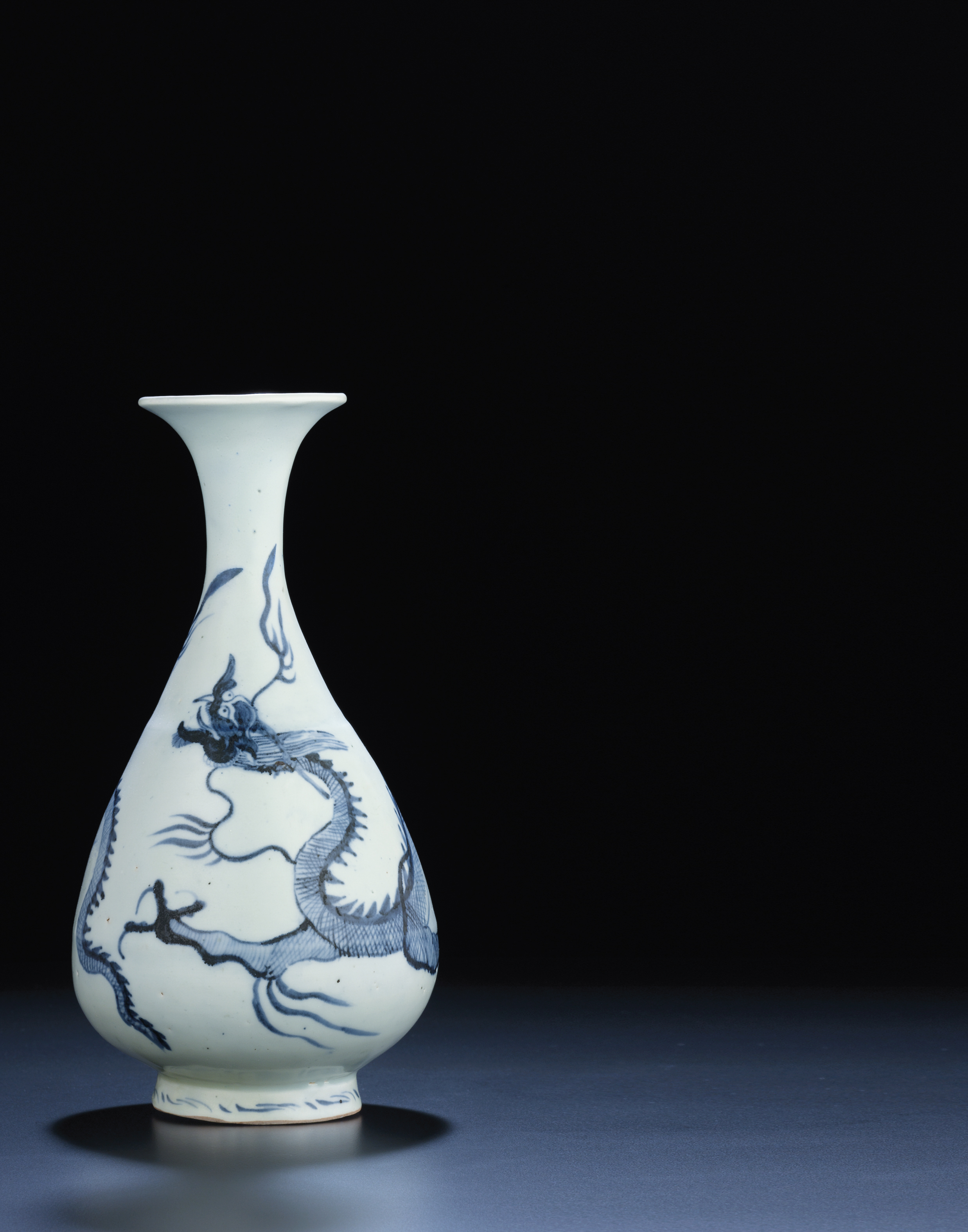
成交總額
HKD 350,000
估價
HKD 300,000 – HKD 400,000
元 青花龍紋玉壺春瓶
瓶圓腹,外撇足,喇叭口,繪三爪遊龍趕珠,足圈環卷草紋一周。
單繪游龍趕珠的玉壺春瓶並不常見,日本大阪市立東洋陶磁美術館藏一件,見2000年上海出版《元代青花瓷》,87頁,圖版3-45號。另一件先後由C. E. Russell Collection及Alfred Clark伉儷收藏,並參加1935-1936倫敦中國藝術國際展覽會(展品編號1434),2011年4月7日於香港蘇富比玫茵堂珍藏專拍中拍賣,拍品38號。
此器1998年4月28日於香港蘇富比拍賣,拍品726號。
來源
Previously sold at Sotheby’s Hong Kong, 28 April 1998, lot 726
拍品專文
Striding dragons chasing a flaming pearl are a very effective motif applied to the swelling bodies of pear-shaped vases yuhuchun ping such as the current example, but are relatively rare. A slightly smaller pear-shaped vase with similarly disposed dragon to that on the present vessel is in the collection of the Museum of Oriental Ceramics in Osaka illustrated by Zhu Yuping in Yuandai qinghua ci, Wenhui chubanshe, Shanghai, 2000, p. 87, no. 3-45. Another slightly smaller vase formerly in the collection of Mr. and Mrs. Alfred Clark and previously in the C.E. Russell Collection from which it was loaned to the International Exhibition of Chinese Art, held at the Royal Academy of Arts, London in 1935-6 (exhibit no. 1434) is illustrated by Sir Harry Garner in Oriental Blue and White, Faber and Faber, London, 1954, pl. 3. The vase was later sold at Sotheby’s Hong Kong, The Meiyintang Collection, 7 April 2011, lot 38. A further example was excavated in 1988 from a tomb of the Wengniute Banner at Wutonghua, north of Chifeng and was exhibited in Empires Beyond the Great Wall – The Heritage of Genghis Khan, Natural History Museum of Los Angeles County, 1993, p. 141, no. 91.
These vases, along with the current example, do not have any motifs other than the ‘flaming pearl’ accompanying the three-clawed dragons, but a somewhat larger pear-shaped vase in the collection of the Henan Provincial Museum is decorated with a four-clawed dragon accompanied by fungus-shaped clouds (illustrated by Zhu Yuping, op.cit., p. 101, no. 4-15). A pear-shaped vase with cut-down neck and a three-clawed dragon in the collection of the British Museum, London, also shows the dragon accompanied by clouds and additionally had a petal band around the lower part of the body illustrated by Jessica Harrison-Hall, Ming Ceramics in the British Museum, British Museum Press, London, 2001, p. 72-3, no. 1:29.
The type of energetic three-clawed dragon seen on the current vase also provided a popular theme on stem cups, as can be seen from an example in the collection of the Palace Museum, Beijing illustrated in Blue and White Porcelain with Underglaze Red (I), The Complete Collection of Treasures of the Palace Museum, Commercial Press, Hong Kong, 2000, p. 14, no. 12, and two examples in the collection of the British Museum, London illustrated by Jessica Harrison-Hall, op. cit., pp. 70-1, nos. 1:24 and 1:25 and on lot 3807 of this sale.
編製圖錄及詳情
拍品前備註
VARIOUS PROPERTIES
参考:纽约大都会博物馆 元青花卉纹 玉壶春瓶 Faceted Vase
ca. first half of the 14th century
China
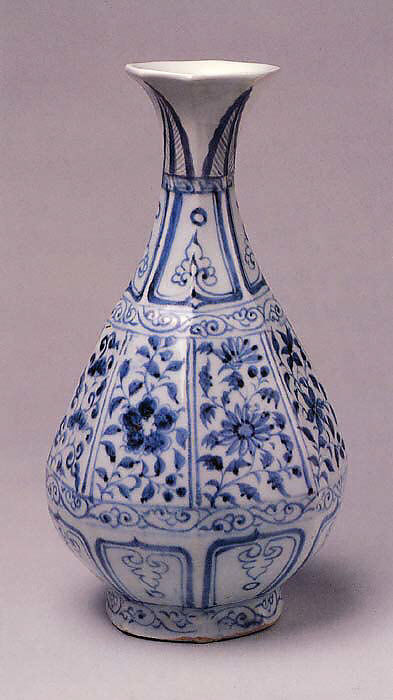
Object Details
Period:Yuan dynasty (1271–1368)
Date:ca. first half of the 14th century
Culture:China
Medium:Porcelain painted in underglaze blue
Dimensions:H. 9 1/8 in. (23.2 cm); Diam. 5 in. (12.7 cm); Diam. of rim 2 1/2 in. (6.4 cm); Diam. of foot 2 7/8 in. (7.3 cm)
Classification:Ceramics
Credit Line:Gift of Stanley Herzman, in memory of Adele Herzman, 1991
Accession Number:1991.253.34
Provenance
Stanley Herzman , New York (until 1991; donated to MMA)
Exhibition History
New York. The Metropolitan Museum of Art. “A Selection of Chinese Ceramics from the Adele and Stanley Herzman Collection,” June 1, 1990–August 26, 1990.
Timeline of Art History
Timelines
Central and North Asia, 1000-1400 A.D.
China, 1000-1400 A.D.
参考:纽约大都会博物馆 元青花卉纹 玉壶春瓶 Vase
ca. first half of the 14th century
China

Object Details
Period:Yuan dynasty (1271–1368)
Date:ca. first half of the 14th century
Culture:China
Medium:Porcelain painted in underglaze blue
Dimensions:H. 11 1/4 in. (28.6 cm); Diam. 5 1/4 in. (13.3 cm); Diam. of rim 2 7/8 in. (7.3 cm); Diam. of foot 3 1/4 in. (8.3 cm)
Classification:Ceramics
Credit Line:Gift of Stanley Herzman, in memory of Adele Herzman, 1991
Accession Number:1991.253.33
Provenance
Stanley Herzman , New York (until 1991; donated to MMA)
Exhibition History
New York. The Metropolitan Museum of Art. “A Selection of Chinese Ceramics from the Adele and Stanley Herzman Collection,” June 1, 1990–August 26, 1990.
Timeline of Art History
Timelines
Central and North Asia, 1000-1400 A.D.
China, 1000-1400 A.D.
参考:拍卖结果 > 伦敦苏富比2015年亚洲艺术品春季拍卖会 > 中国艺术珍品 > 元 青花鸳鸯踏荷纹盌
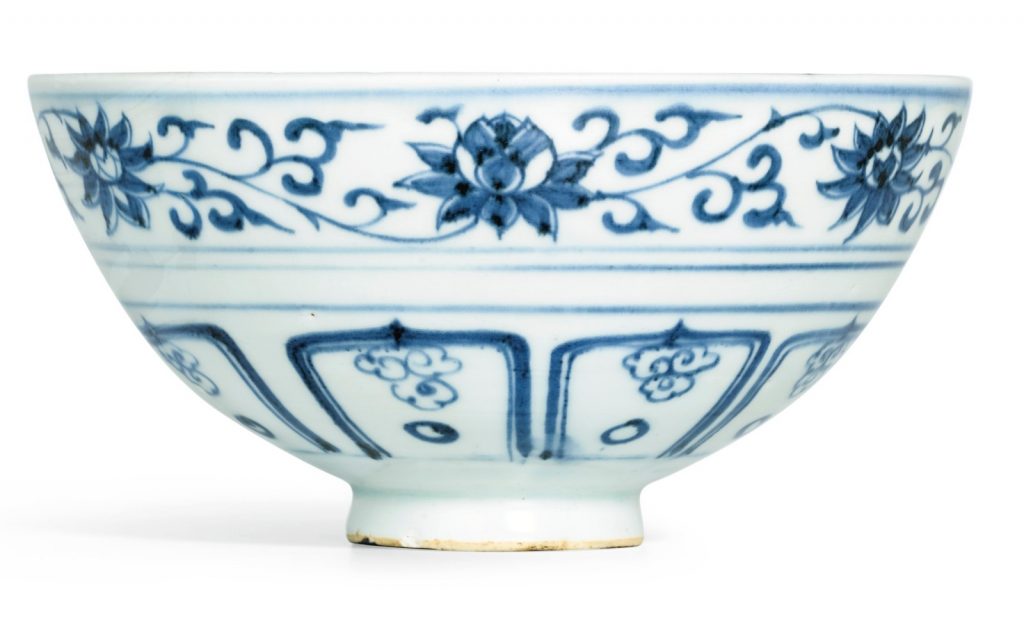
拍卖信息
Lot 109 元 青花鸳鸯踏荷纹盌
估价:80,000-120,000 GBP
成交价: 112,500 GBP (含买家佣金)
尺寸:
18公分,7英寸
参考:拍卖首页 > 佳士得香港有限公司 > 2005秋季拍卖会 > 重要中国陶瓷 LOT号: 1406 元 青花龙纹玉壶春瓶
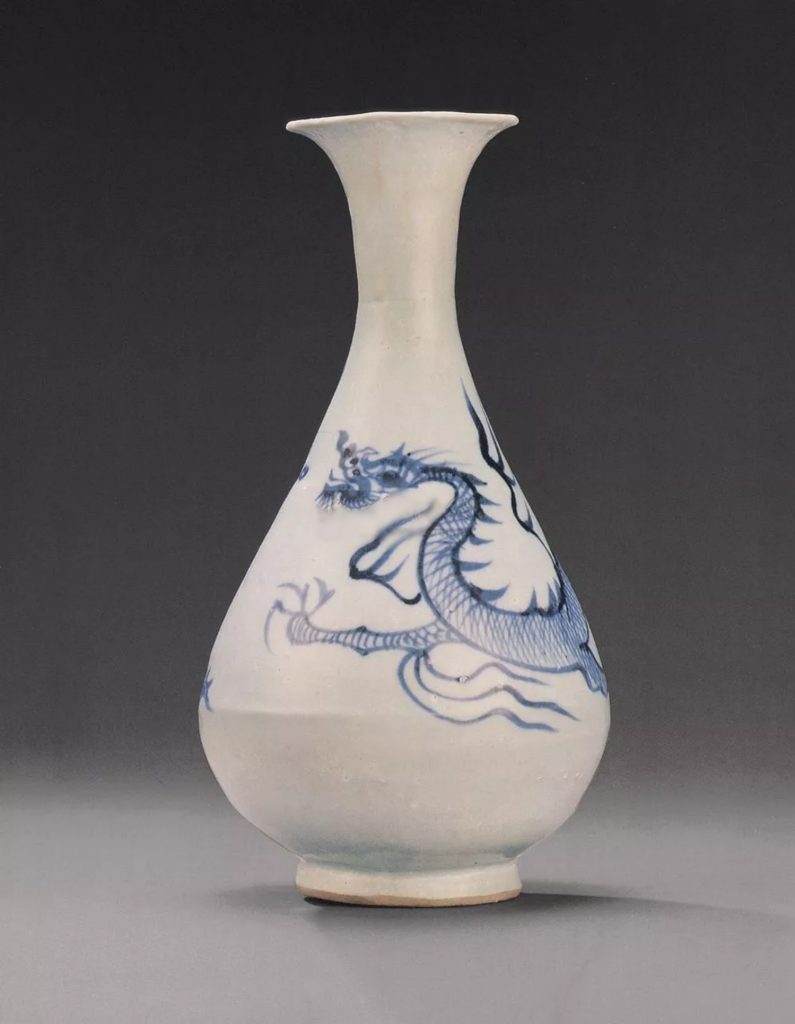
拍品信息
作者 — 尺寸 高27.4cm
作品分类 陶瓷>元代以前陶瓷 创作年代 元
估价 HKD 550,000-750,000
成交价
流拍
专场 重要中国陶瓷 拍卖时间 2005-11-28
拍卖公司 佳士得香港有限公司 拍卖会 2005秋季拍卖会
参考: 拍卖结果 > 伦敦苏富比2015年亚洲艺术品春季拍卖会 > 灵逸博雅:井上恒一珍藏中国艺术 > 元 青花赶珠龙纹玉壶春瓶
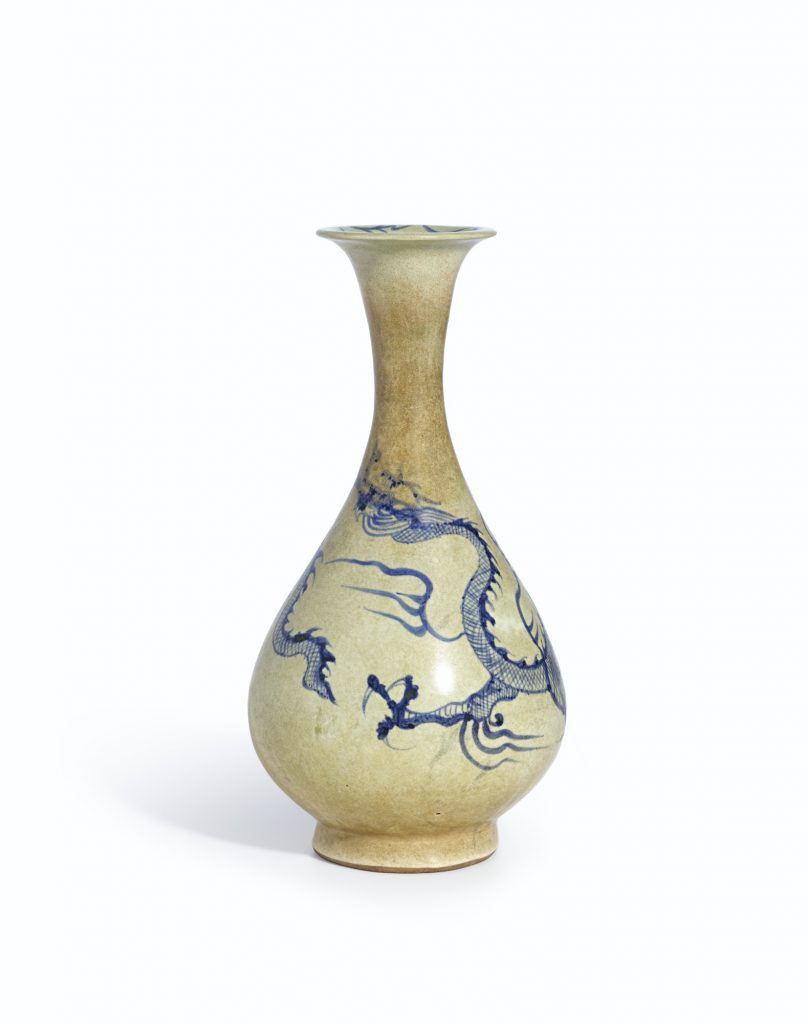
拍卖信息
Lot 37 元 青花赶珠龙纹玉壶春瓶
估价:5,000-7,000 GBP
成交价: 20,000 GBP (含买家佣金)
尺寸:
数量: 228.8公分, 11 3/8 英寸
参考:拍卖结果 > 日本美协2018春季拍卖会 > 中国古董珍玩日场 > 元 青花龙纹玉壶春瓶
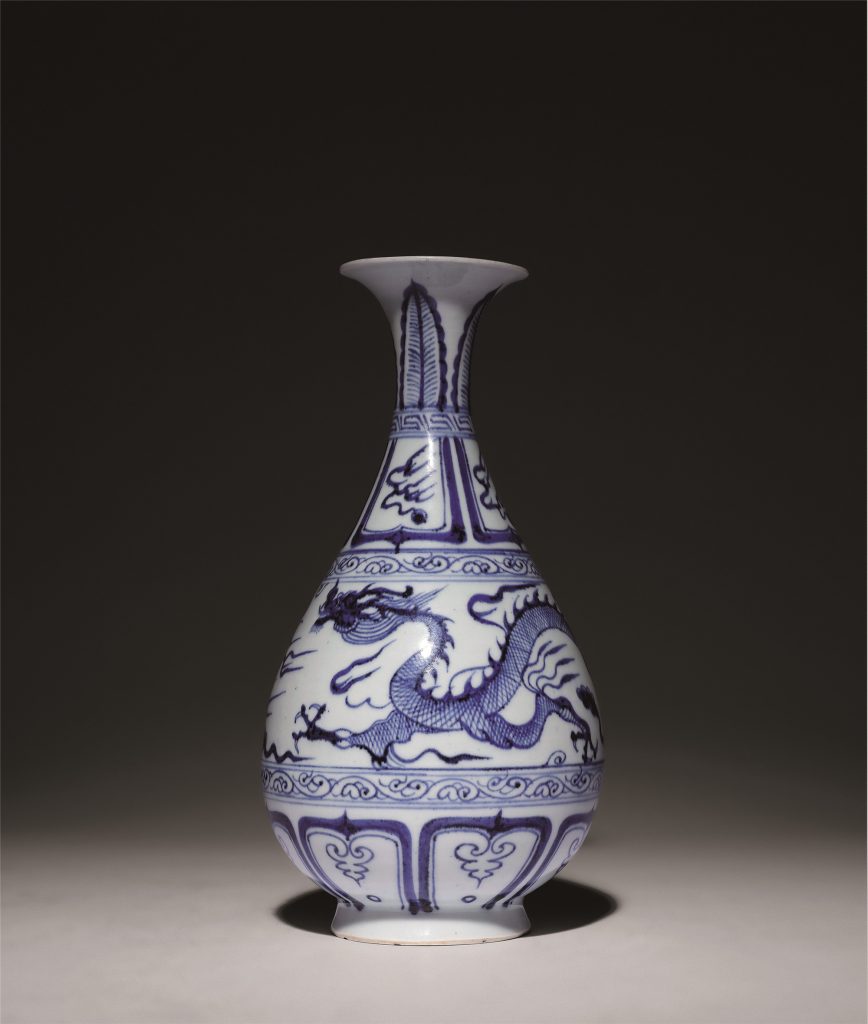
拍卖信息
Lot 1193 元 青花龙纹玉壶春瓶
估价:1,500,000-1,500,000 JPY
暂无数据
尺寸:
高29cm
拍品说明:
说明:此拍品呈玉壶春瓶的样式,是中国瓷器造型中的一种典型器形,演变自唐代寺院的净水瓶。圆口外撇,细颈中央微微收束,向下逐渐加宽为杏圆状下垂腹,圈足,弧线变化柔和,整体显得隽秀文静,带有一种沉着安稳的高雅气质。通体施青白釉,釉质显莹润,釉色白中透青,充满韵味。瓶撇口处有一圈青花卷草纹,给原本略显平实的瓶口增添了一份层次感与立体感,口沿一侧有损处以金修补。瓶颈外侧施蕉叶纹、回纹和俯莲纹,分别代表事业兴旺、富贵不断和高洁吉祥;瓶腹两道卷草纹样之间绘出朵朵祥云,云雾之间一条巨龙正在尽情畅翔,龙身伸展弯曲,极富张力,更有瑞光祥火缠绕四周,突出表现了飞龙在天的威严与气势。胫部缀仰莲纹,足边饰莲瓣,显得繁缛华丽,象征自性清净,心无尘染。此瓶器形秀美雅致,施釉浓郁,青花着色轻快爽朗,线条清晰运笔流畅,构图丰满,层次多而不乱,体现出元代青花的特点,为当时青花瓷烧造的上乘之作。参考:首都博物馆藏“景德镇窑青花鸳鸯戏水玉壶春瓶”,《中国陶瓷全集•元(下)》P163,No.179
参考:拍卖结果 > 日本美协2018春季拍卖会 > 中国古董珍玩日场 > 元 青花龙纹高足杯
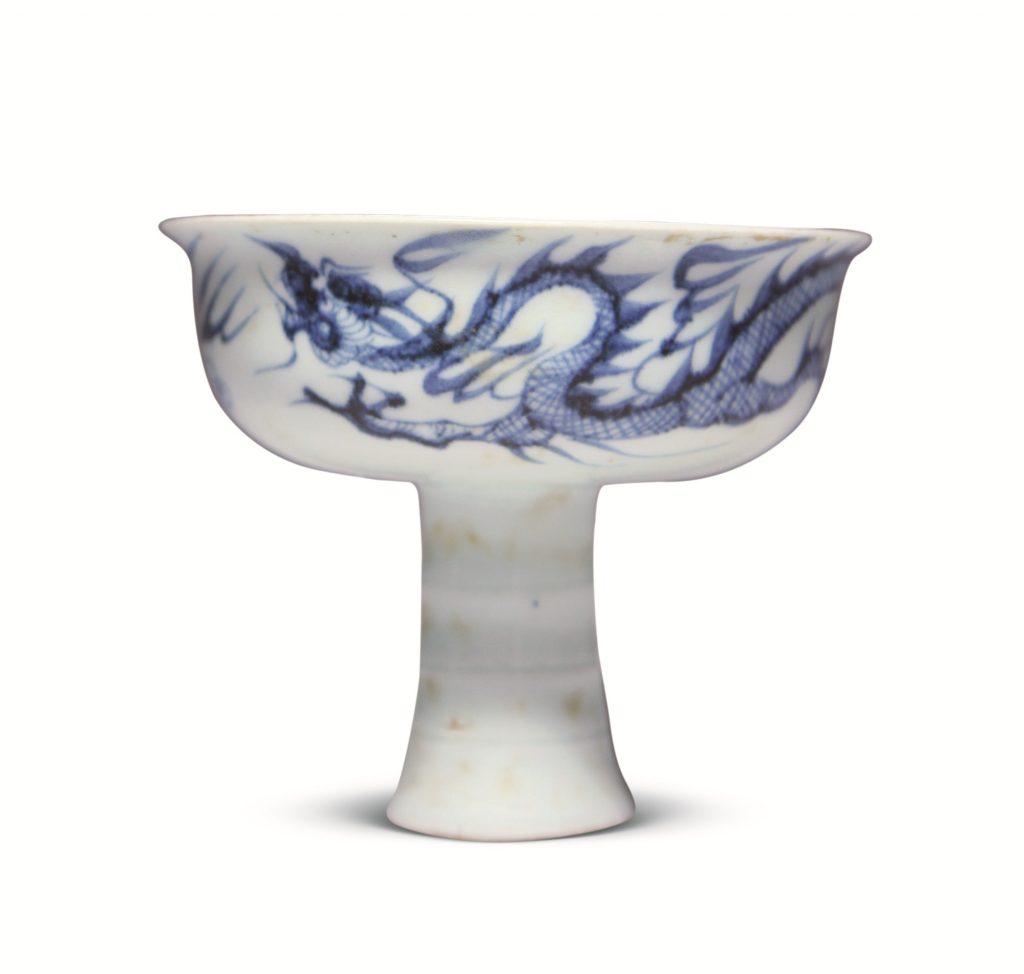
拍卖信息
Lot 1611 元 青花龙纹高足杯
估价:300,000-300,000 JPY
暂无数据
尺寸:
高9.5cm
参考:拍卖首页 > 澳门中信国际拍卖有限公司 > 2011秋季艺术品拍卖会 > 书画、佛像、陶瓷、玉器杂项 LOT号: 0113 元代 青花云龙纹玉壶春瓶
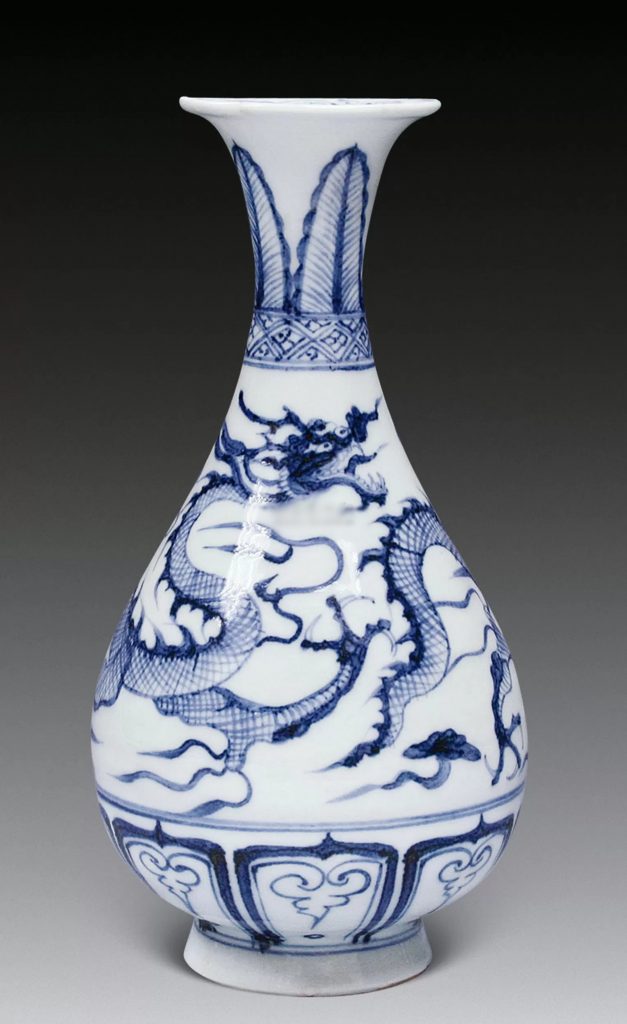
拍品信息
作者 — 尺寸 高24.6cm;直径7.1cm;足径7.2cm
作品分类 陶瓷>元代以前陶瓷 创作年代 元代
估价 HKD 600,000-600,000
成交价
RMB 563,040 HKD 690,000USD 88,320EUR 69,000
专场 书画、佛像、陶瓷、玉器杂项 拍卖时间 2011-11-25
拍卖公司 澳门中信国际拍卖有限公司 拍卖会 2011秋季艺术品拍卖会
说明 撇口,细颈,鼓腹,圈足。青花装饰,颈部绘蕉叶纹,莲瓣纹,腹部主体纹饰绘云龙舞动。玉壶春瓶由宋人诗句“玉壶先春”一词而名。宋代创烧,元、明、清均有烧制。元青花器装饰有鸳鸯、龙纹、凤纹、人物故事图等纹样。元代是中国青花瓷生产的初期,但却以其工艺娴熟,制作精湛而著称于世。此器造型隽秀,胎薄体轻,纹饰清晰,布局严谨,绘制娴熟,为元代青花瓷的精品。此瓶为元代瓷器的典型形制,有青花、釉里红、清白釉等品种。传世元代青花器数量不多,故此器弥足珍贵。
参考:Ming Style Blue and White Vase
OFFERED BY PAGODA RED
$680
Blue and White painted porcelain vase depicting scholar figures and botanical themes with usual animal head handles.
LACE OF ORIGIN: China
DATE OF MANUFACTURE: circa 1950
PERIOD: 20th Century
MATERIALS AND TECHNIQUES: Porcelain
CONDITION: Excellent
WEAR: Wear consistent with age and use
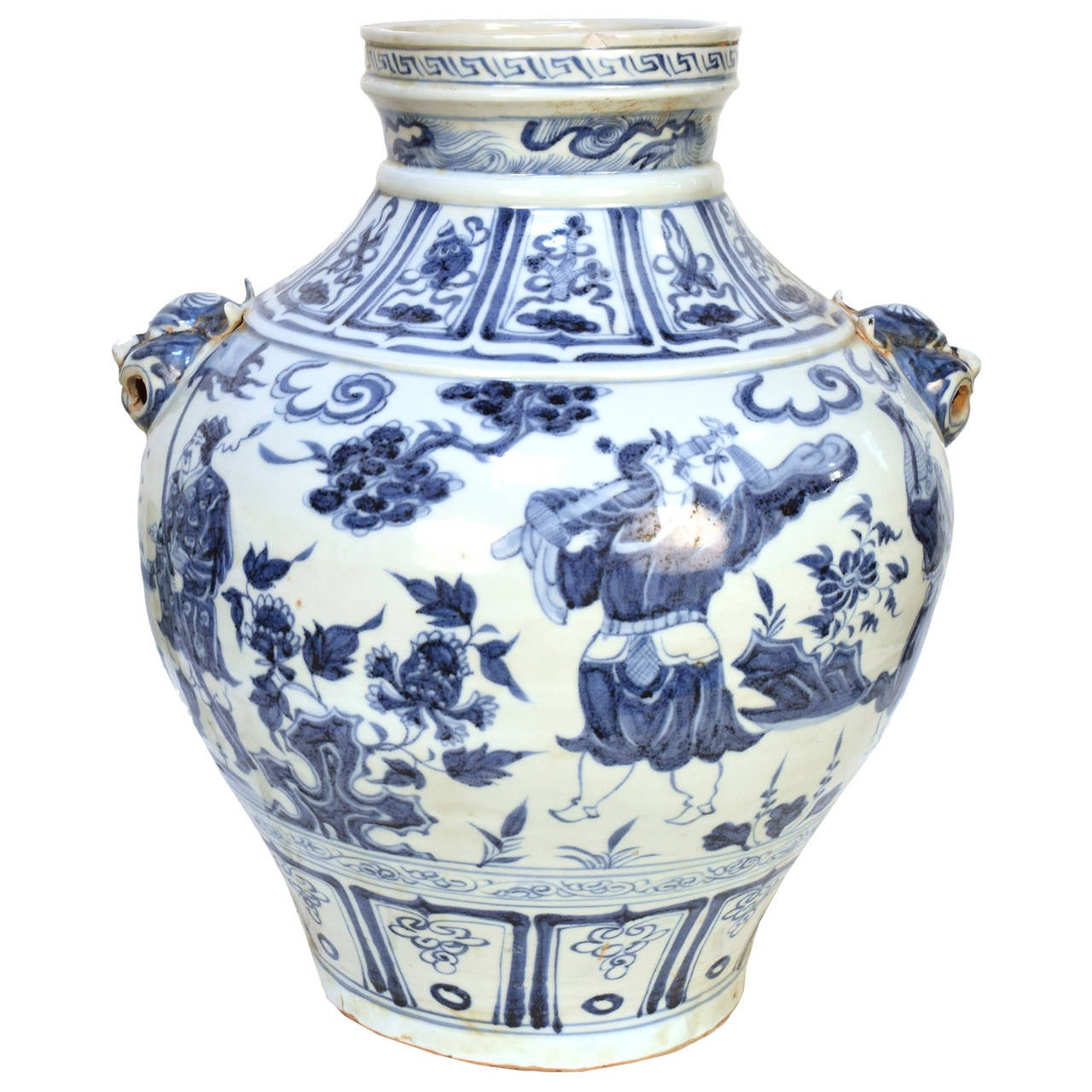

![[临渊阁]天地一家春](https://www.antiquekeeper.ca/wp-content/uploads/2023/03/antiquekeeper_banner_image_2-4.jpg)
